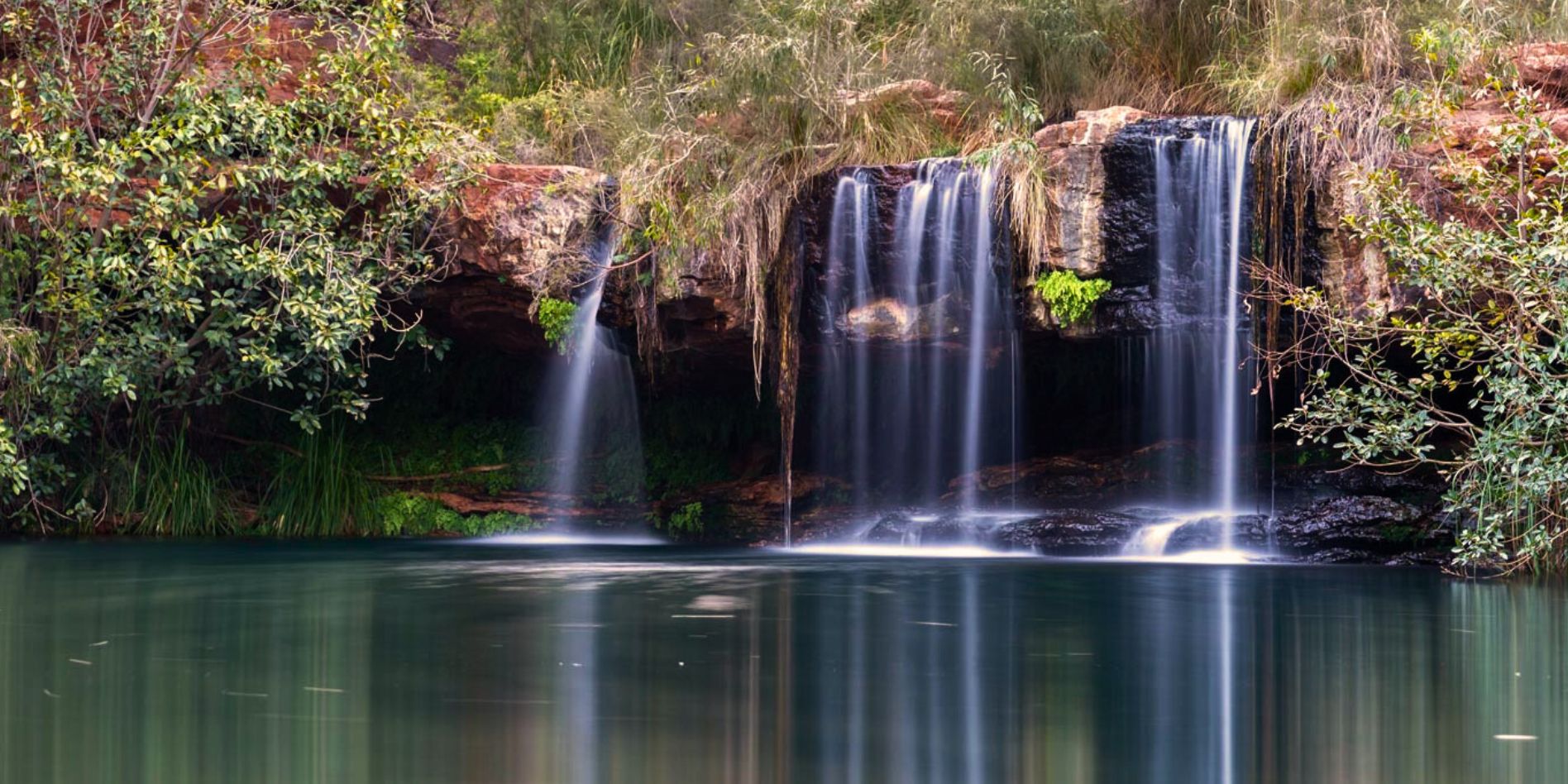Looking for the perfect Karijini itinerary and guide? You’ve come to the right place.
Over five days, we immersed ourselves in this rugged wonderland, exploring its stunning gorges, swimming in crystal-clear pools, and tackling some of the most challenging hikes Karijini offers.
Whether you’re an adventurer looking to push your limits or seeking peaceful moments in nature, Karijini National Park is a place of contrasts—offering both adventure and tranquillity in equal measure.
It is one of our favourite places to camp in Western Australia.
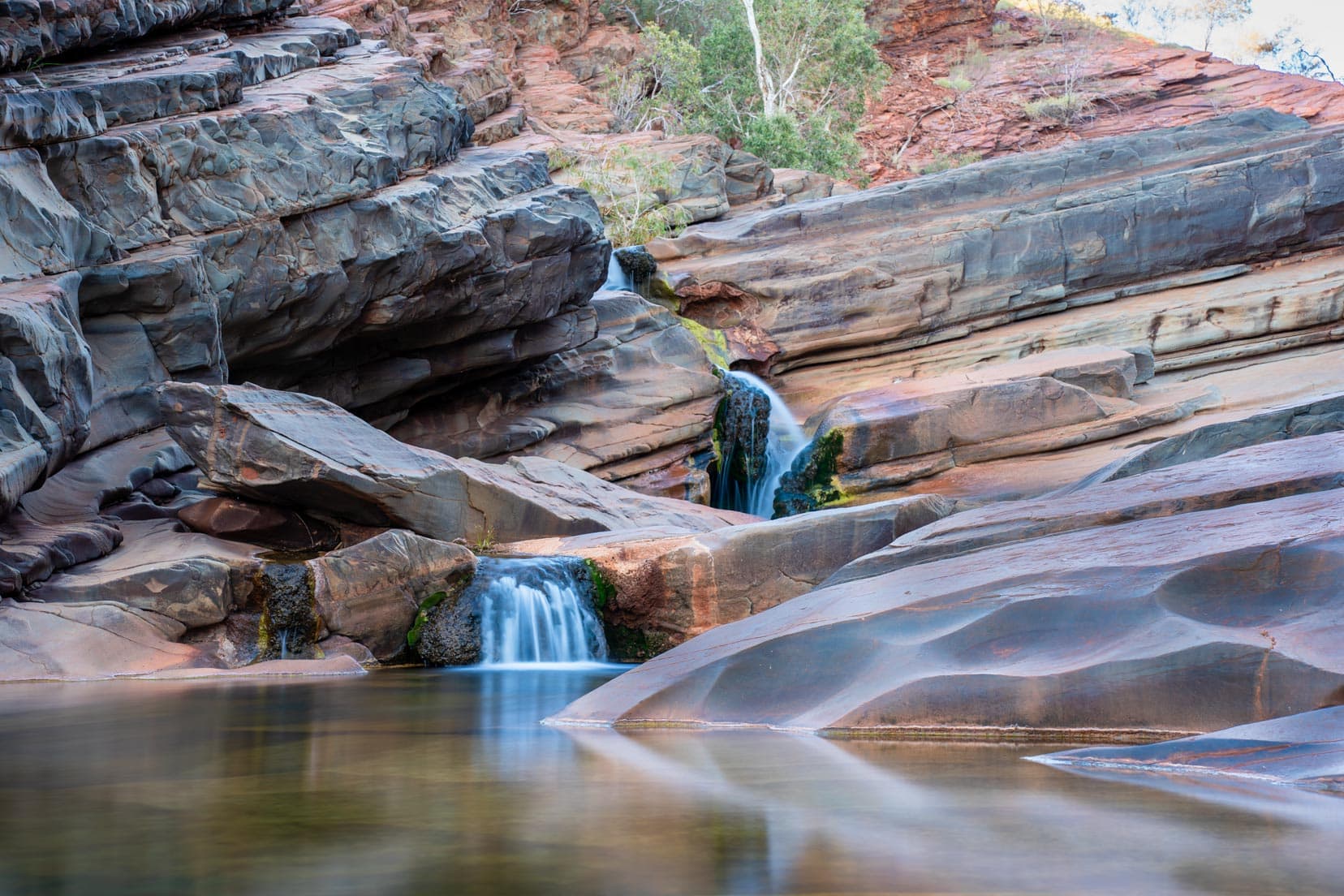
In a Nutshell: Karijini National Park Itinerary & Guide
- Mobile Reception: There is limited coverage within the park. Telstra works at Karijini Eco Retreat and the Visitor Centre but not at Dales Campground. We were told that Optus works at Dales Campground. We’re with Telstra, and there was no signal at all there.
- Stock Up in Tom Price: Last stop for groceries (Coles) and petrol before entering the park.
- Road Conditions: Nearly all roads in Karijini are sealed now, except for the roads leading to Kalamina Gorge and Hamersley Gorge. These unsealed roads are manageable with most vehicles but can be rough, so caution is advised.
- National Park Fees: A $17 entry fee applies to the entire park, which you pay once if staying in Karijini Park but would need to pay each day if entering and exiting the park. No payment is required for Hamersley Gorge.
- Accommodation:
- Various options are available within and near the park. For detailed camping information, see our Karijini Camping Guide.
- Dales Campground (basic, with drop toilets)
- Karijini Eco Retreat (flush toilets, hot showers)
- Visitor Centre: This is a worthwhile stop to learn about the park’s geology, flora, and Indigenous heritage. If you don’t have water shoes (great for the slippery rocks), you can purchase a pair here for $27.
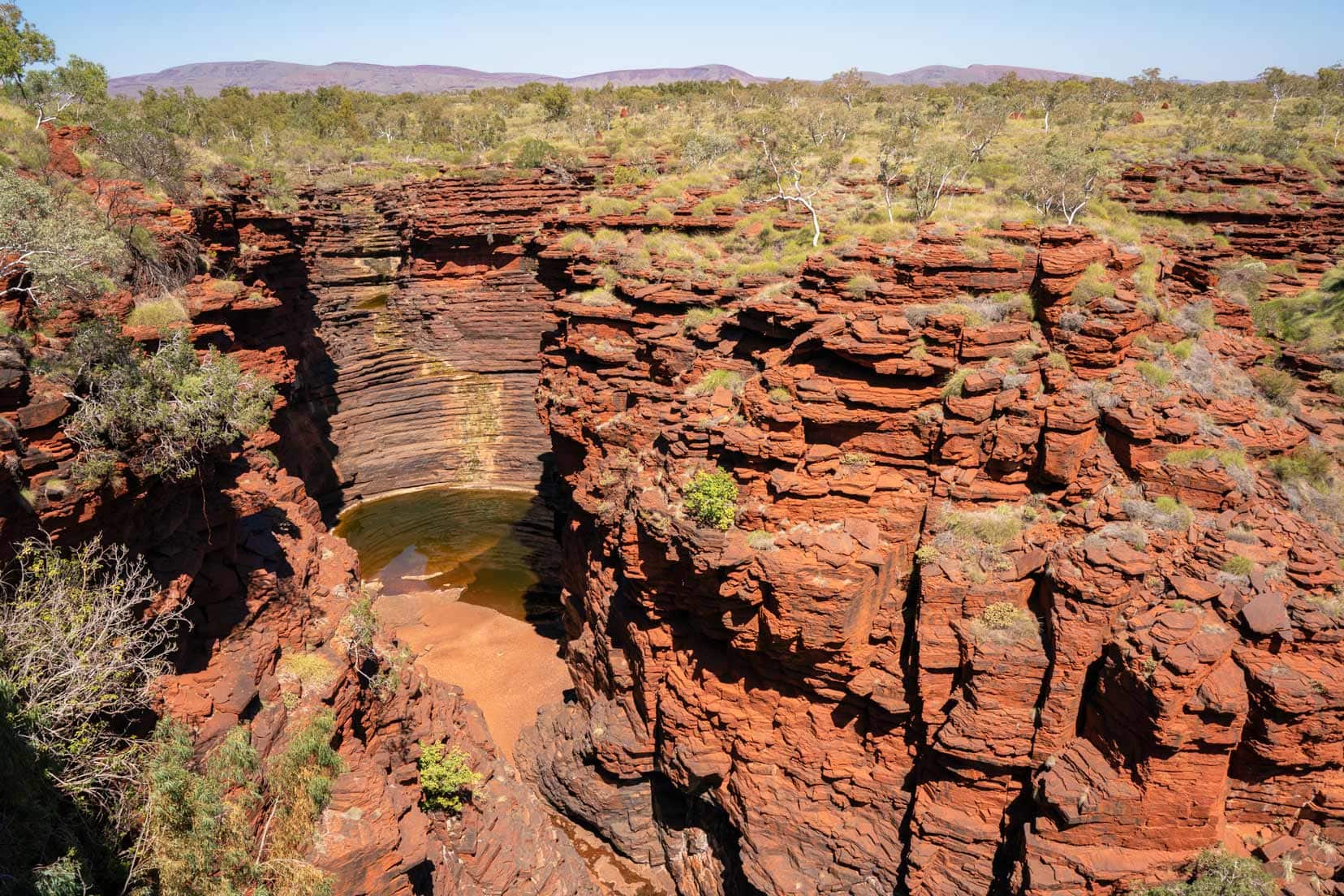
Suggested Karijini Itinerary
- Day 1: Explore Hamersley Gorge: Stay at Free Buddha Camp
- Day 2: Explore Hancock Gorge and Weano Gorge: Stay at Karijini Eco-Retreat
- Day 3: Explore Knox and Joffre Gorges – or admire them from the lookouts: Stay at Karijini Eco-Retreat
- Day 4: Discover the beauty of Kalamina Gorge: Camp at Dales Campground
- Day 5: Swim at Fern Pool and explore Dales Gorge: Camp at Dales Campground
Gorge Highlights: Our Top 3 Must-Visit Gorges
1. Kalamina Gorge
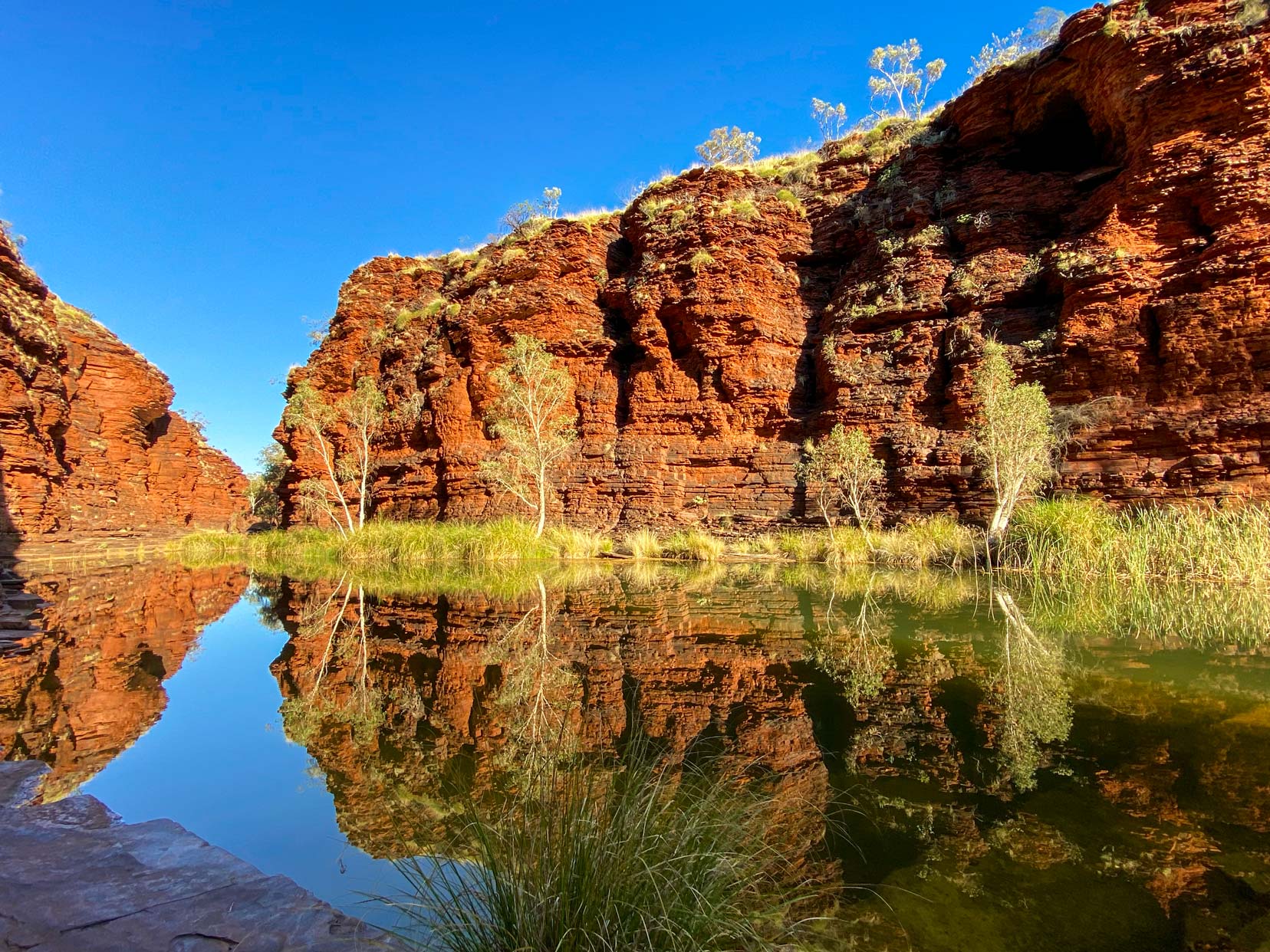
Difficulty Level: Grade 4 (Moderate)
Time: 2-3 hours return
Best Time to Visit: Early morning is best for cooler weather and fewer crowds.
Kalamina Gorge offers serenity and breathtaking reflections in its pools. The relatively easy hike is ideal for those looking for a relaxing, scenic experience. The gorge is quieter than some of the more popular spots, making it a great choice for photography and peaceful exploration.
Pro Tip: Visit just after sunrise to capture the best light reflecting off the gorge walls. It’s also a great time for some solitude before more visitors arrive.
2. Dales Gorge
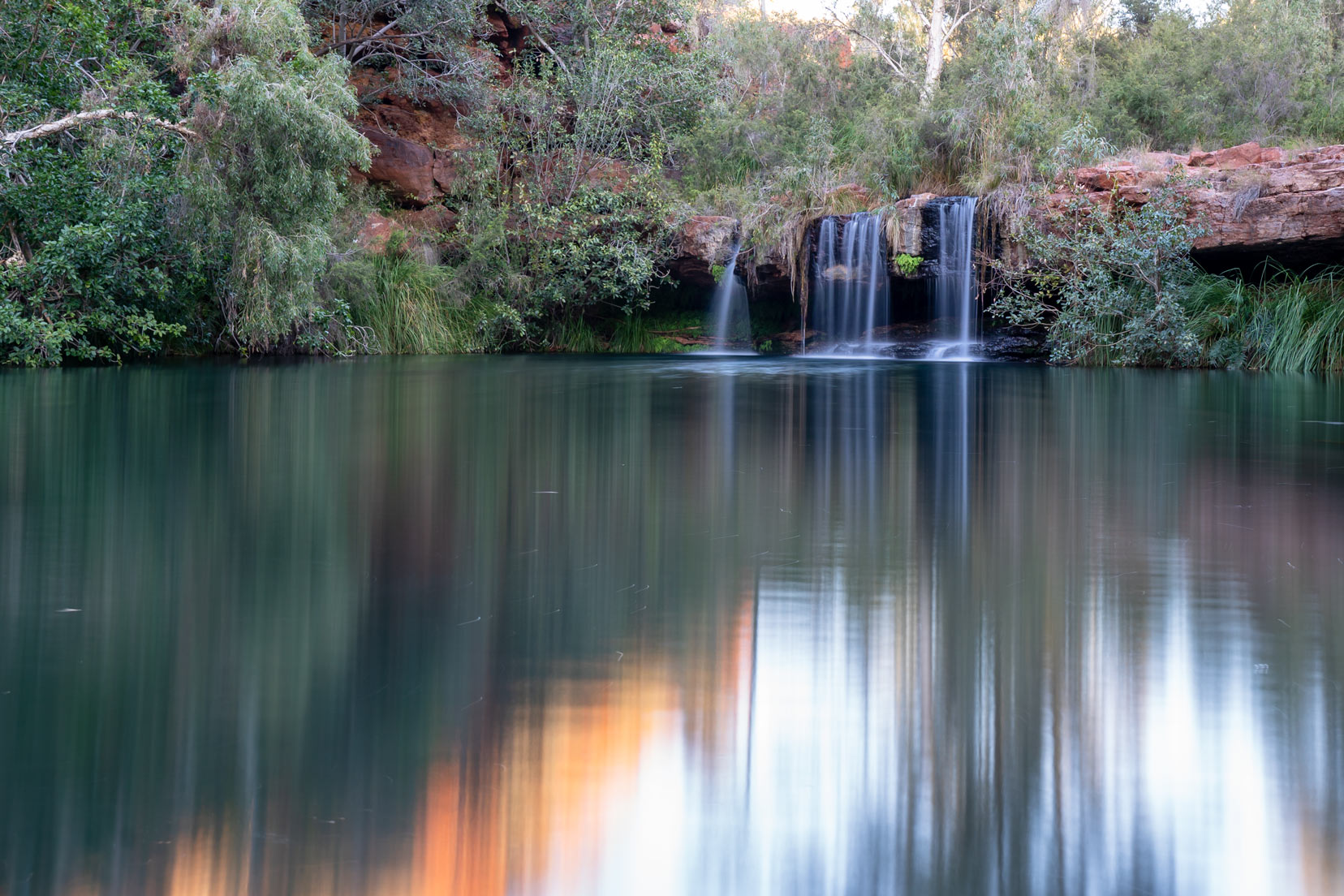
Difficulty Level: Grade 3 (Easy to Moderate)
Time: 2-3 hours return
Best Time to Visit: Early morning for a peaceful swim.
Dales Gorge is home to some of the most famous features in Karijini, including Fern Pool and Fortescue Falls. These natural swimming spots are perfect for cooling off after your hike. The walk through the gorge takes you along stunning rock formations, and there’s plenty of shade for a break along the way.
Pro Tip: Start your hike early to enjoy Fern Pool in peace. The flying foxes in the trees make this spot a memorable place for a swim.
3. Hamersley Gorge
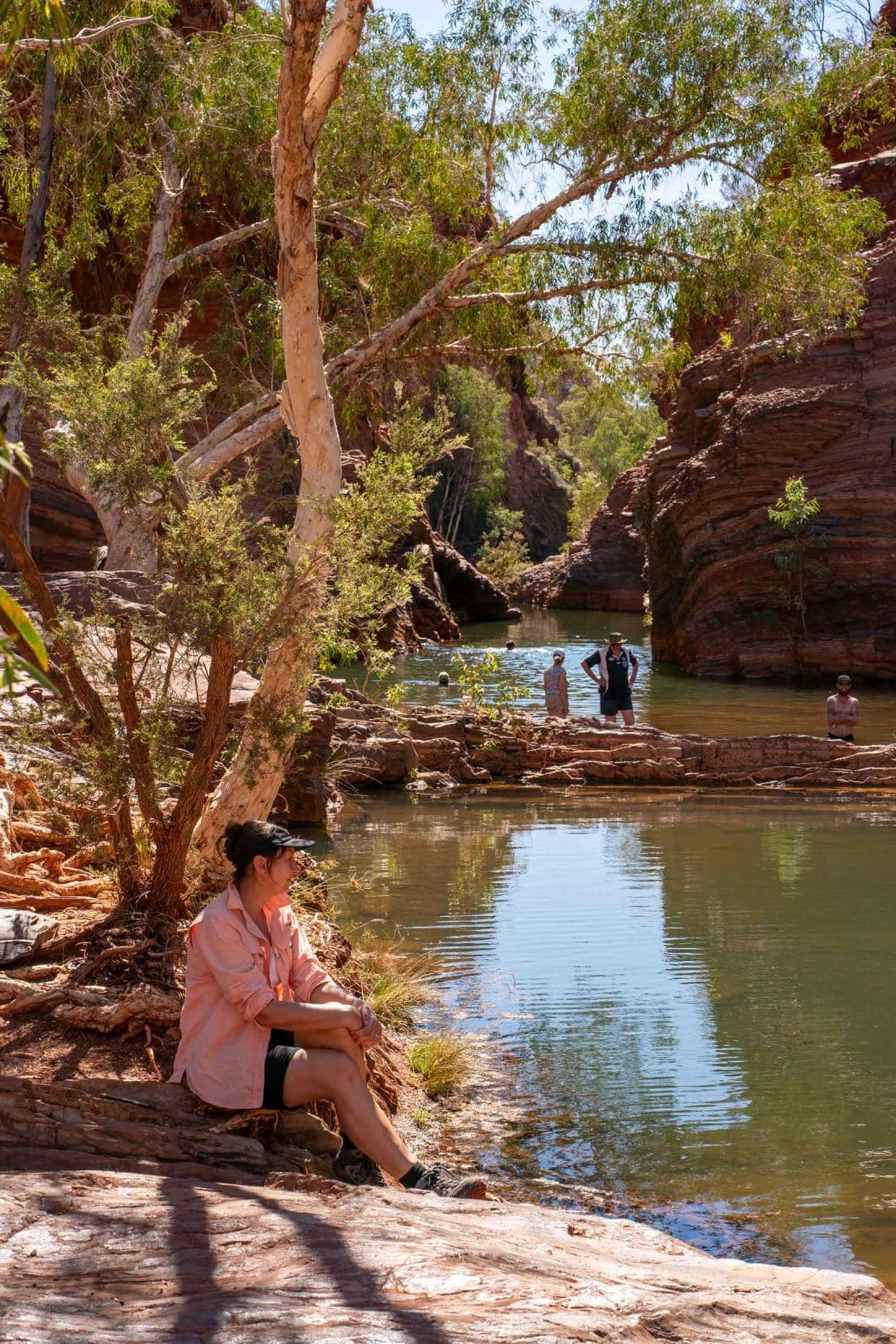
Difficulty Level: Grade 4 (Moderate, some scrambling required)
Time: 1-2 hours return
Best Time to Visit: Sunrise to enjoy the gorge before it gets busy.
The iconic Spa Pool at Hamersley Gorge is a must-see. Its unique rock formations make it a favourite for photographers. While climbing up to the pool can be tricky, the rewarding dip in the cool waters and the stunning scenery make the effort worthwhile.
Pro Tip: The rocks around Spa Pool can be very slippery, so take care when scrambling down. Bring a camera for sunrise shots when the light enhances the gorge’s vibrant colours.
If you are short on time while visiting Karijini National Park, these are our top three picks.
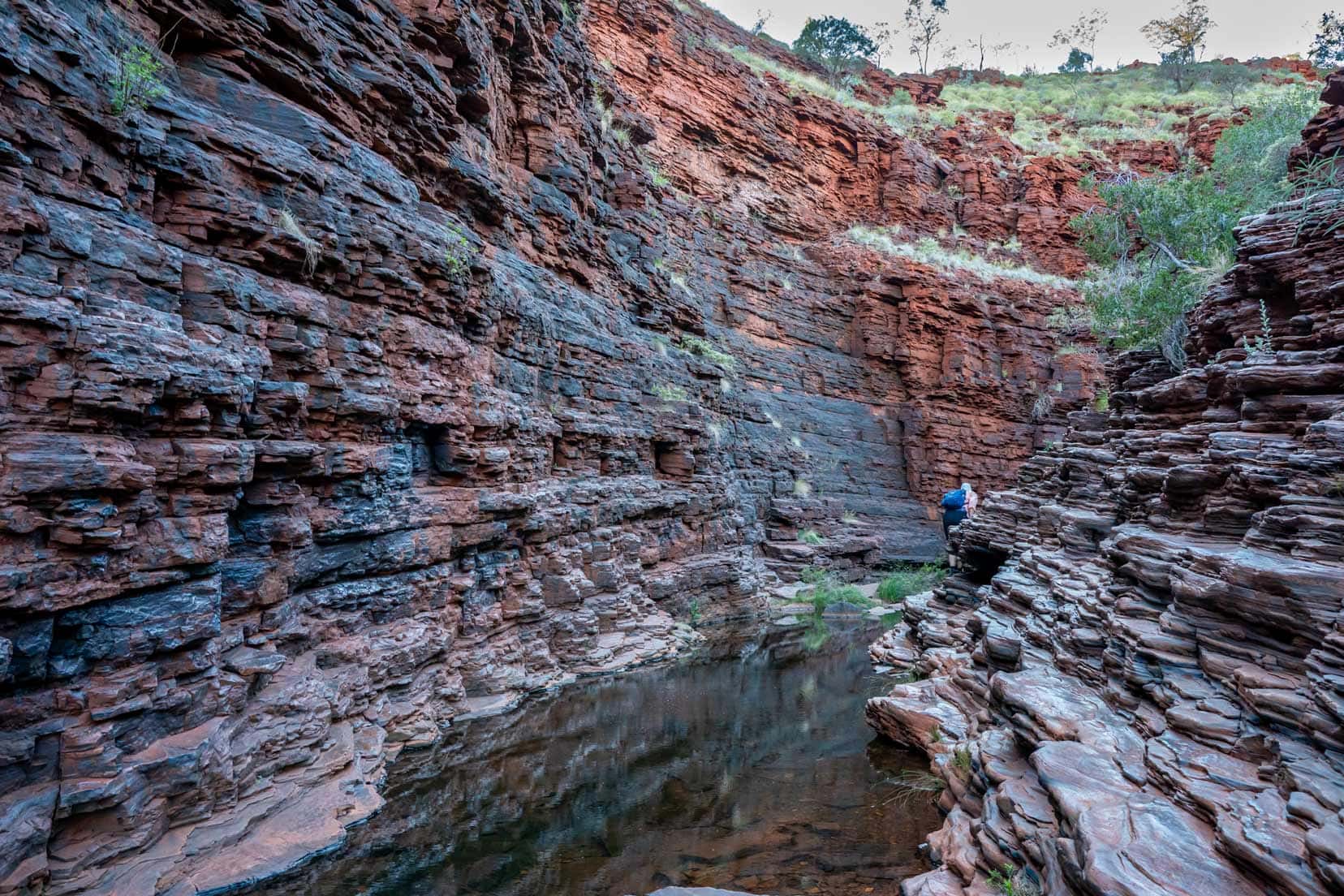
Explore Karijini’s Gorges: Video Highlights
Now that you’ve got the essential tips for visiting Karijini, take a visual journey through its most stunning gorges.
This video highlights all the must-see spots from our itinerary, including the serene pools of Kalamina Gorge, the dramatic cliff walls of Hancock Gorge, and the refreshing waters of Fern Pool in Dales Gorge.
See the beauty of Karijini for yourself and get inspired to plan your adventure!
Karijini National Park Map
Where is Karijini?
Karijini National Park covers a vast 627,422 hectares, making it the second-largest national park in Western Australia—only the remote Rudall River National Park (now called Karlamilyi National Park) is larger.
To give you an idea of its scale, Karijini is roughly the size of over 880,000 football fields! Located in the heart of the Hamersley Range in the Pilbara region, around 1,400 km north of Perth, Karijini’s remote setting enhances its appeal.
The park is traditionally the home of the Banyjima, Kurrama, and Innawonga Aboriginal people. In the Banjima language “Karijini” refers to the Hamersley Range, and it is of significant importance to the local aboriginal community.
Its towering gorges, striking rock formations, and crystal-clear pools offer some of Australia’s most breathtaking landscapes.
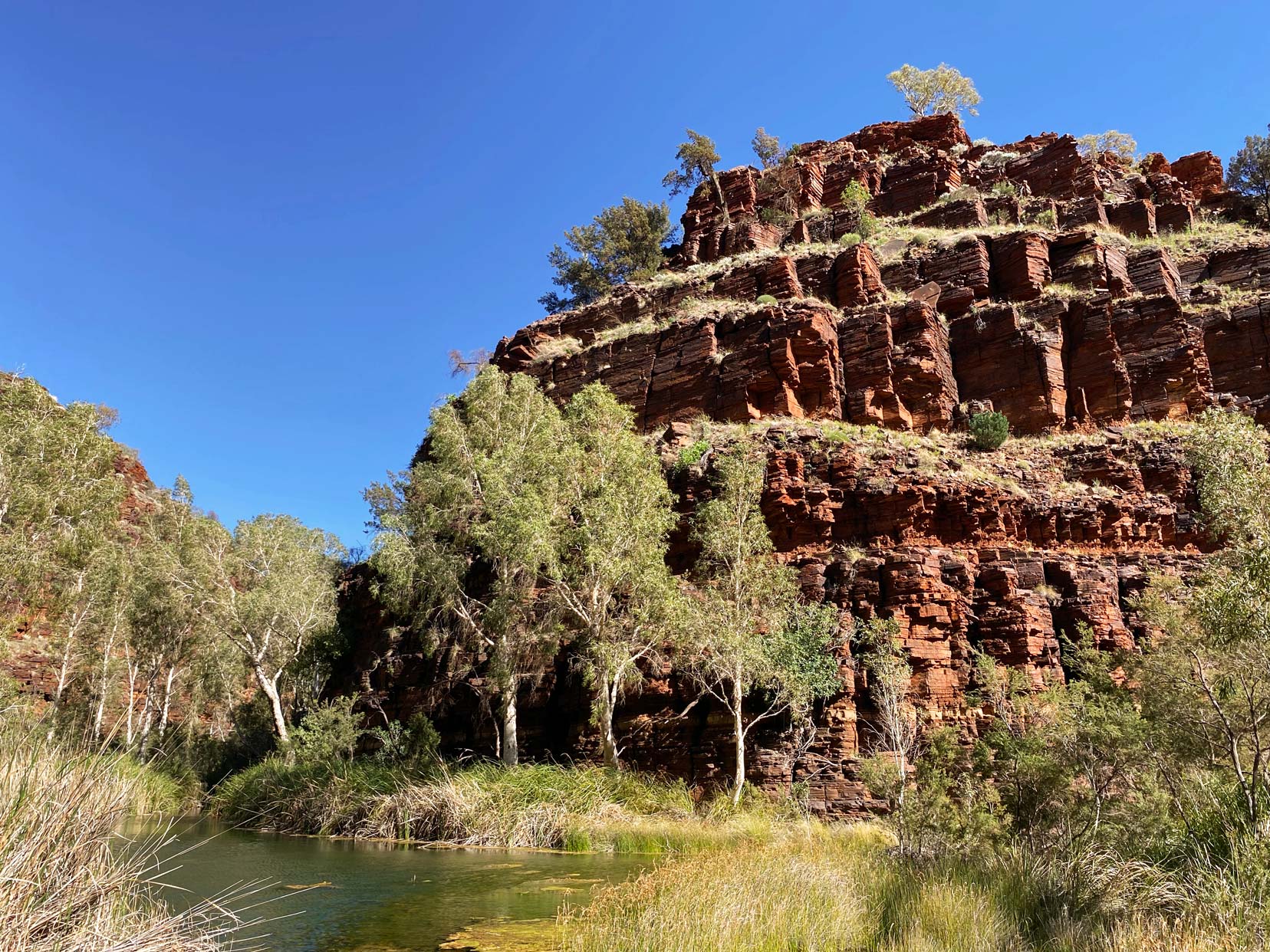
Our Karijini National Park Itinerary
This is our exact itinerary, but instead of doubling up on Hammersley Gorge, you can follow the suggested itinerary above.
This will give you an idea of our time and leave time to relax back at camp after your morning exploring. If you are younger and fitter, you could easily fit in more hiking in one day.
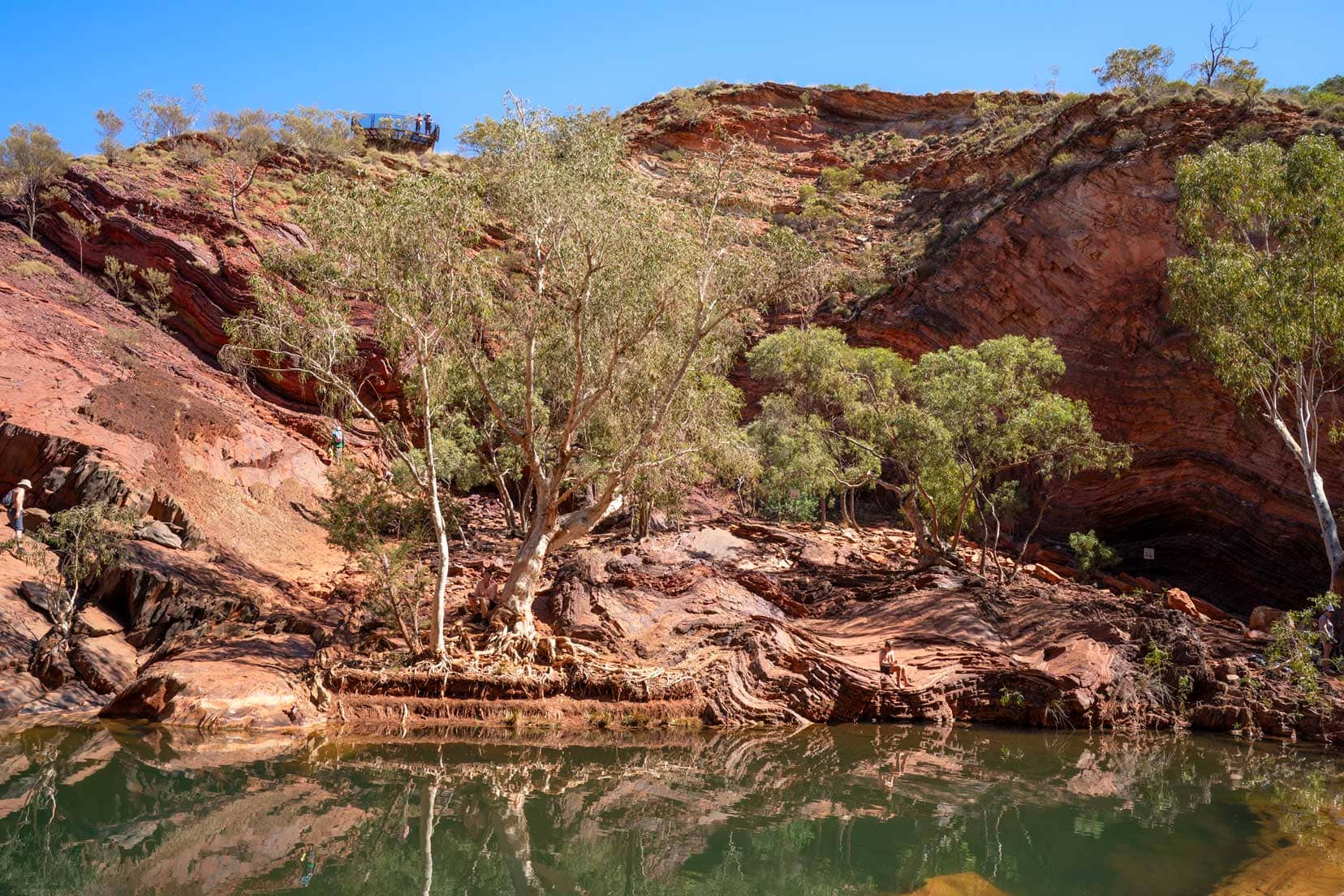
Day 1: Exploring Hamersley Gorge
We left Tom Price and headed straight to Hamersley Gorge on the park’s west side. Despite the rough, unsealed road, the journey was worth every bump.
When we arrived around 10 am, the area was bustling with visitors, all eager to dip in the cool, inviting waters—especially on a 33-degree day.
There is a small lookout at the top and a short, steep climb down to the gorge by rocky steps. At the bottom, you are immediately at the swimming pools.
Turn right at the bottom of the steps to access the famous ‘Spa Pool’ at Hammersley Gorge.
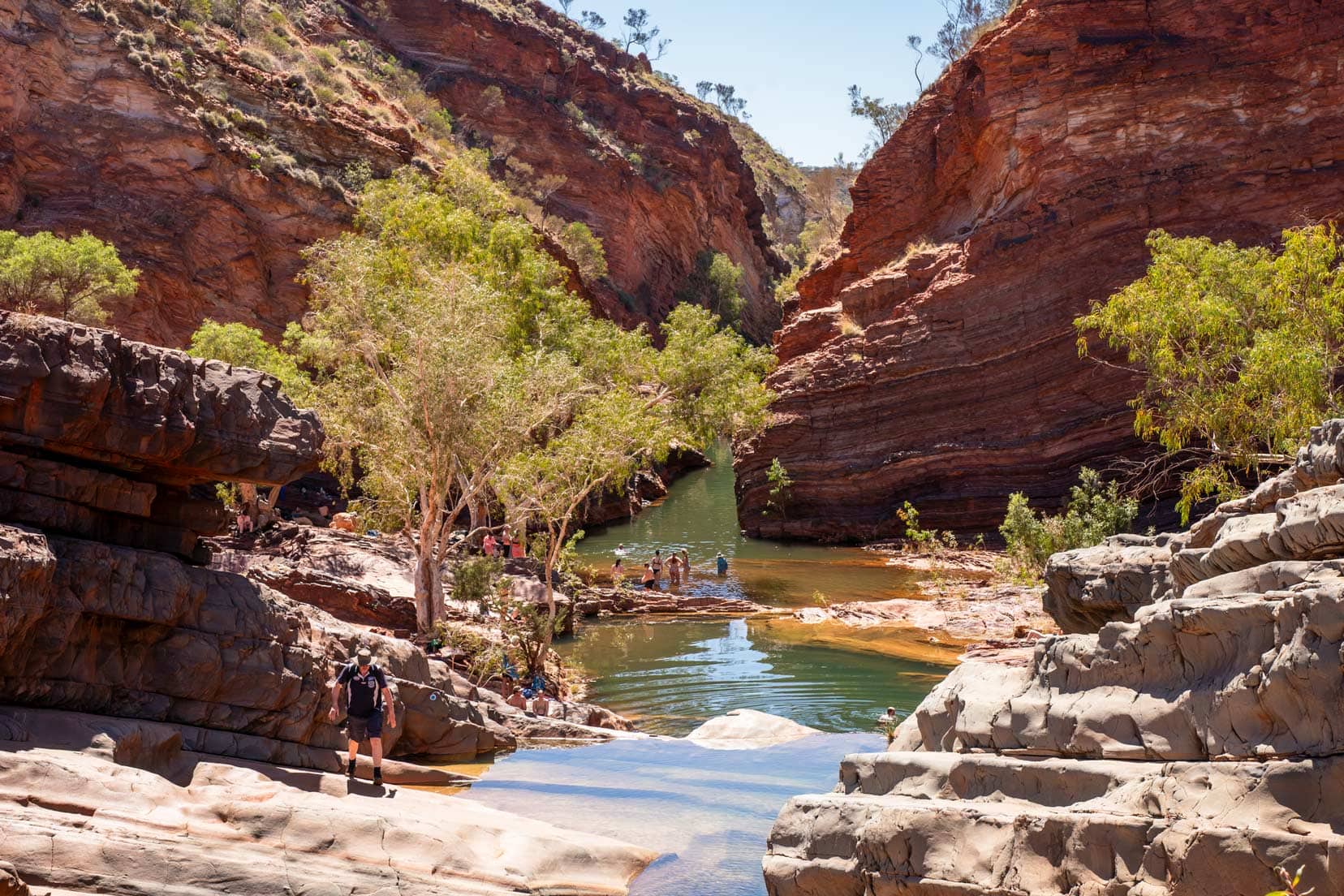
The gorge’s Spa Pool is a must-see, though getting there involves a bit of a climb. It’s not too bad getting up, but the smooth steepness of the rock made getting back down challenging—I did it mainly on my bottom!
The gorge’s layered rock formations are a photographer’s dream, making the climb well worth the effort.
Pro Tip: The rocks around the Spa Pool can be slippery. Wearing sturdy hiking shoes or water shoes will help you navigate safely, especially when scrambling down to the pool.
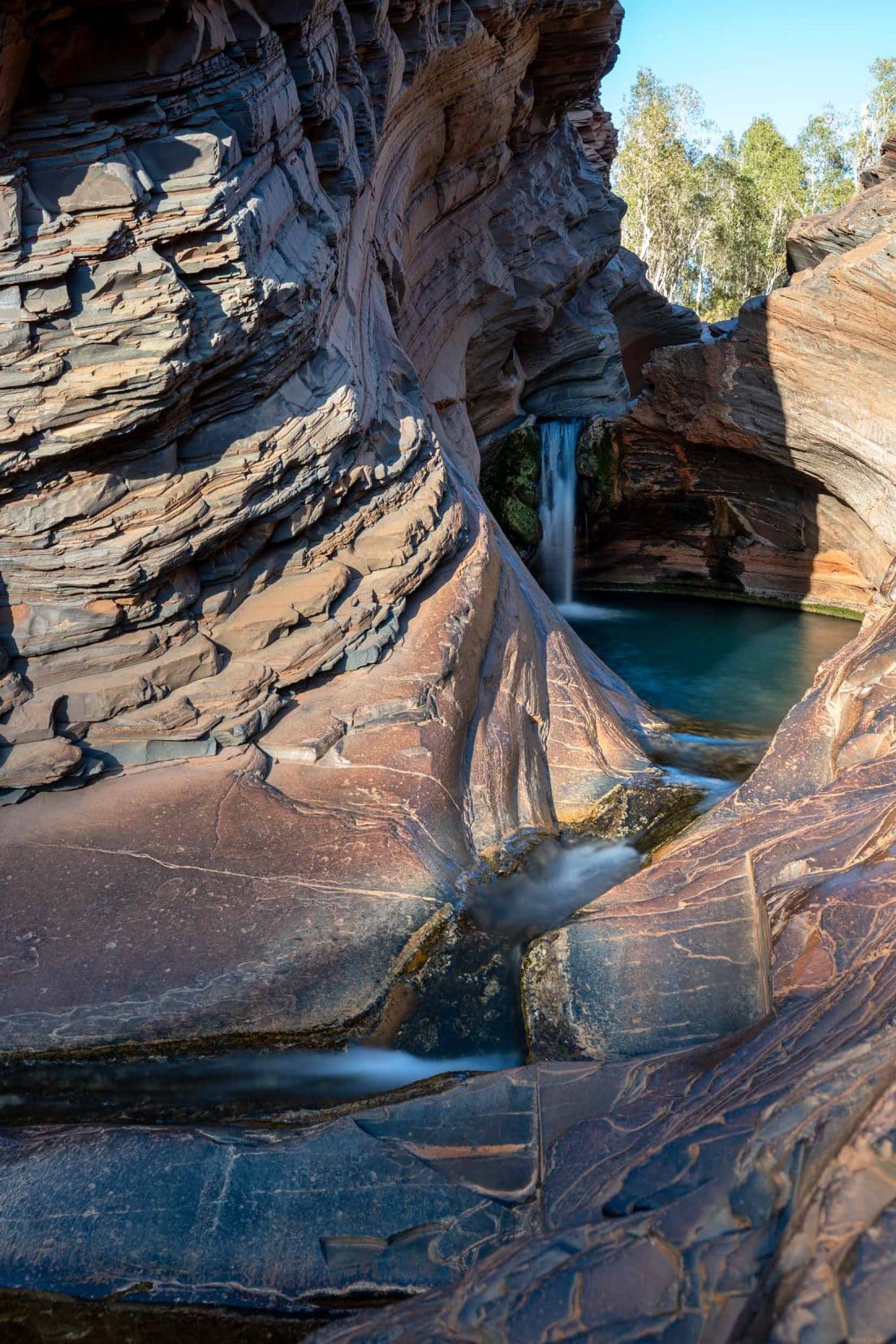
Where to Stay: Buddas Camp
We stayed the night at Buddas Camp – a free wild camp just opposite the turn-off to Hammersley Gorge on the Nanutarra-Munjina Road.
Day 2: Early Morning Magic at Hamersley Gorge
Hamersley Gorge so enchanted us that we returned the following day at 7 am. This time, we had the gorge all to ourselves, which made the experience even more magical.
We tackled the Spa Pool again and then slid back down to the main pool area.
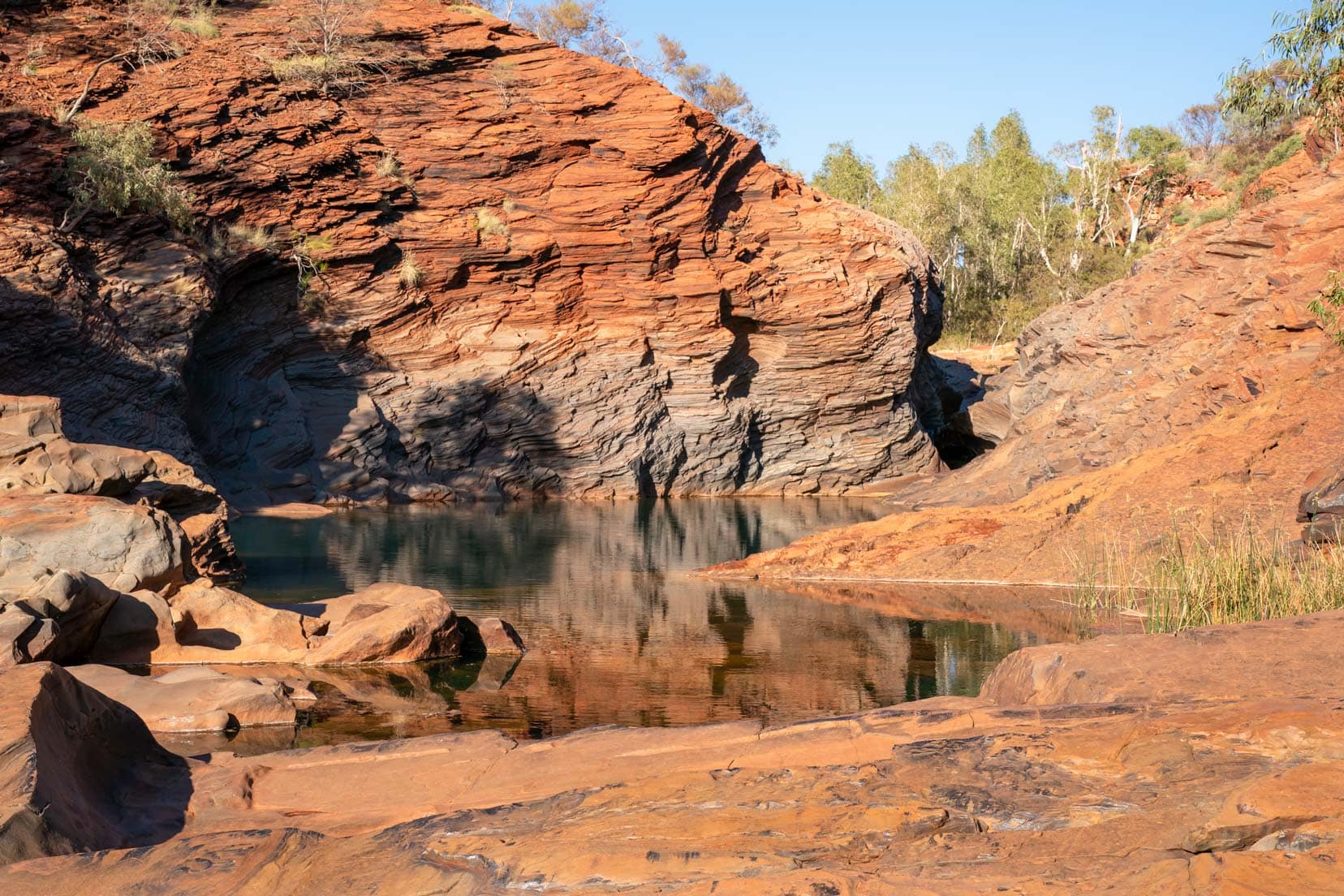
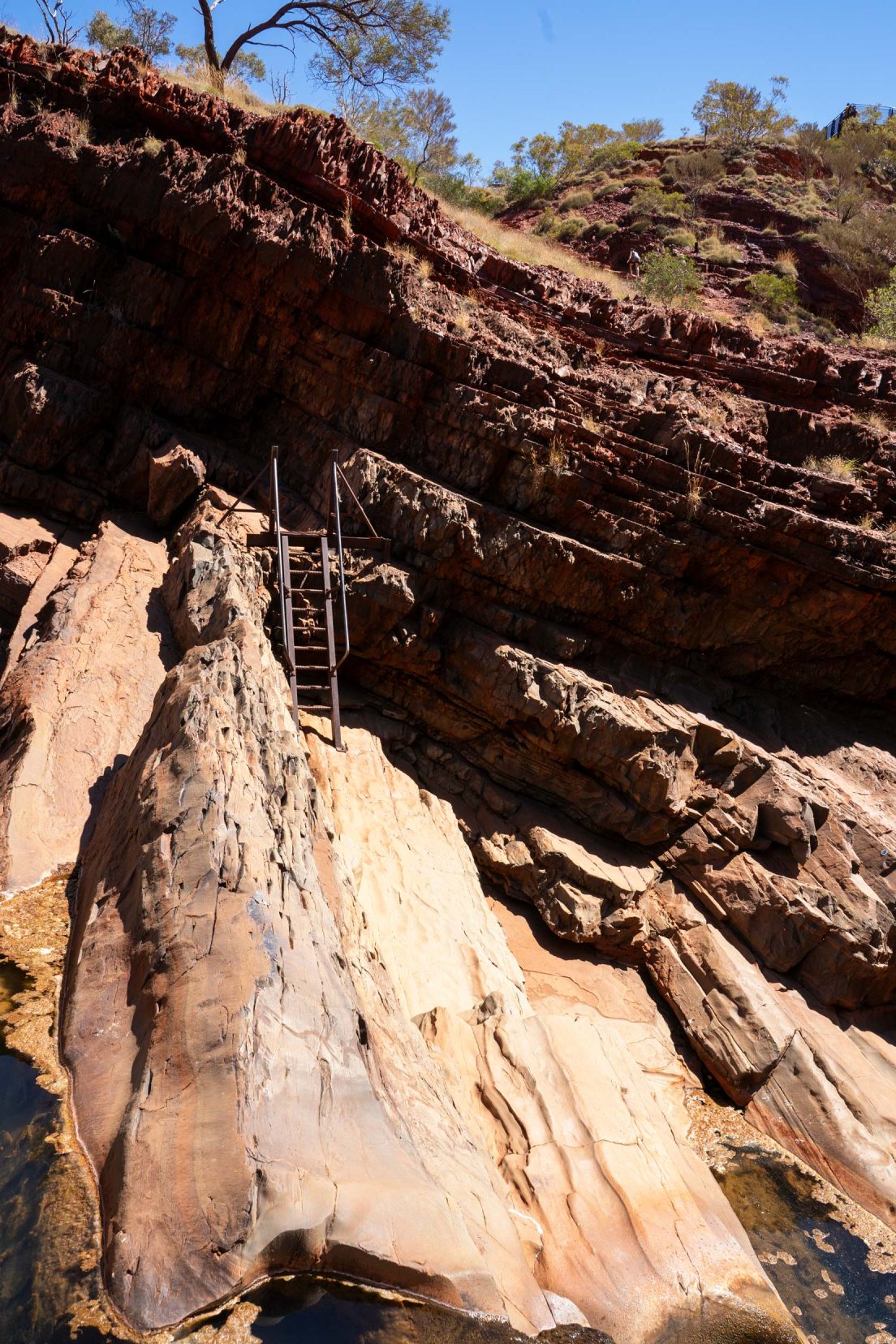
The real highlight was swimming through the narrow gorge, surrounded by towering walls and lush vegetation.
It was one of the most beautiful and peaceful swims I have ever experienced. Just enter the pool in the central area and swim about 250 metres to your left.
It was just beautiful.
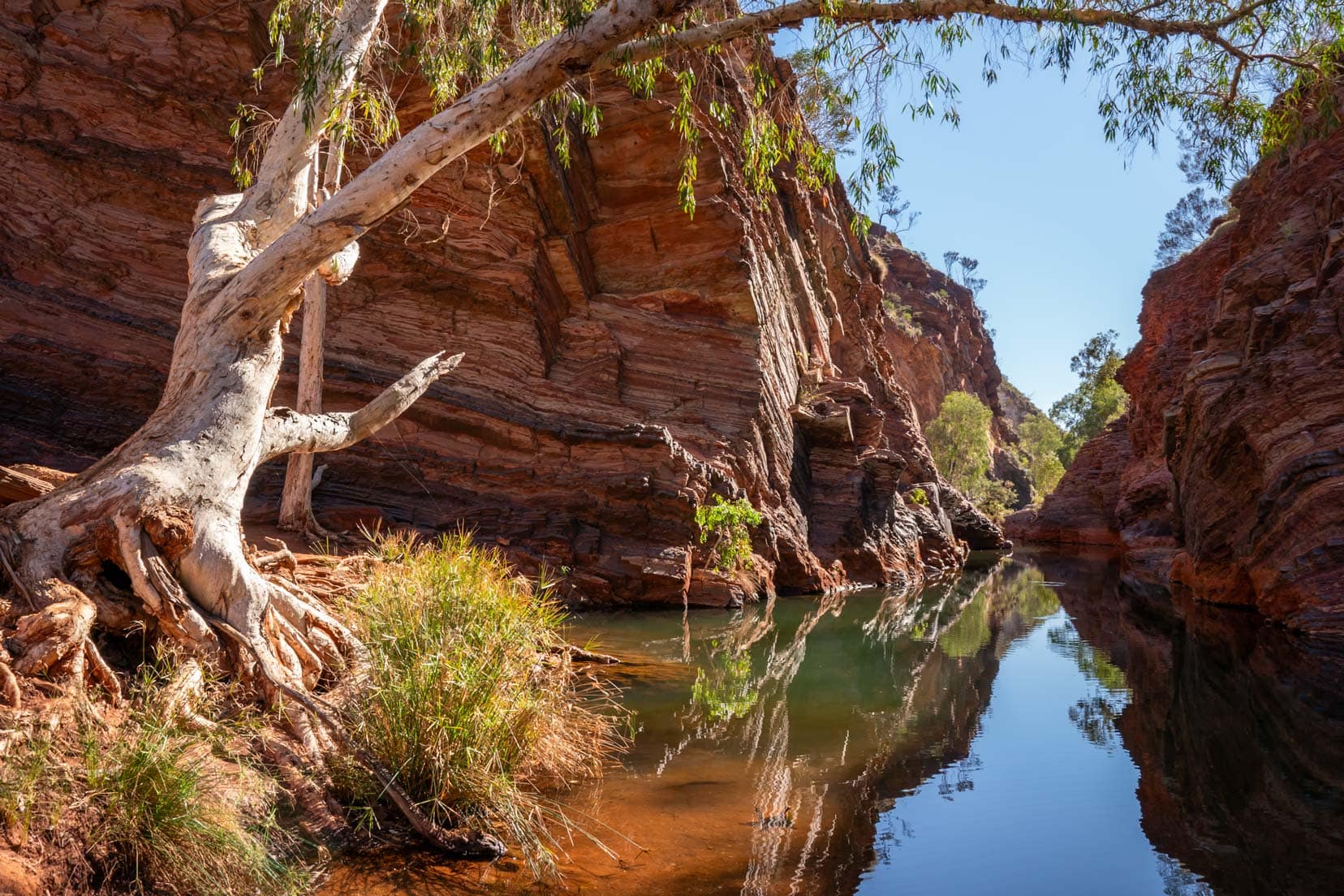
Pro Tip: For the best experience, visit early in the morning before the sun hits the water and other visitors arrive.
We then set up camp at Karijini Eco-Retreat, where we stayed for two nights. We were going to visit Joffre Gorge, but it was too hot then, so we just relaxed in camp.
Where to Stay: Karijini Eco-Retreat
We stayed two nights at Karijini Eco-Retreat. The camp has hot showers, flush toilets, a restaurant, and a bar.
Day 3: Hancock Gorge, Weano Gorge, Knox Gorge, and Joffre Gorge
This day was a busy day packed with adventure!
Hancock Gorge
We started our day early, eager to take on the challenging terrain. The descent into Hancock Gorge begins with a steep metal ladder, immediately setting the tone for the adventure.
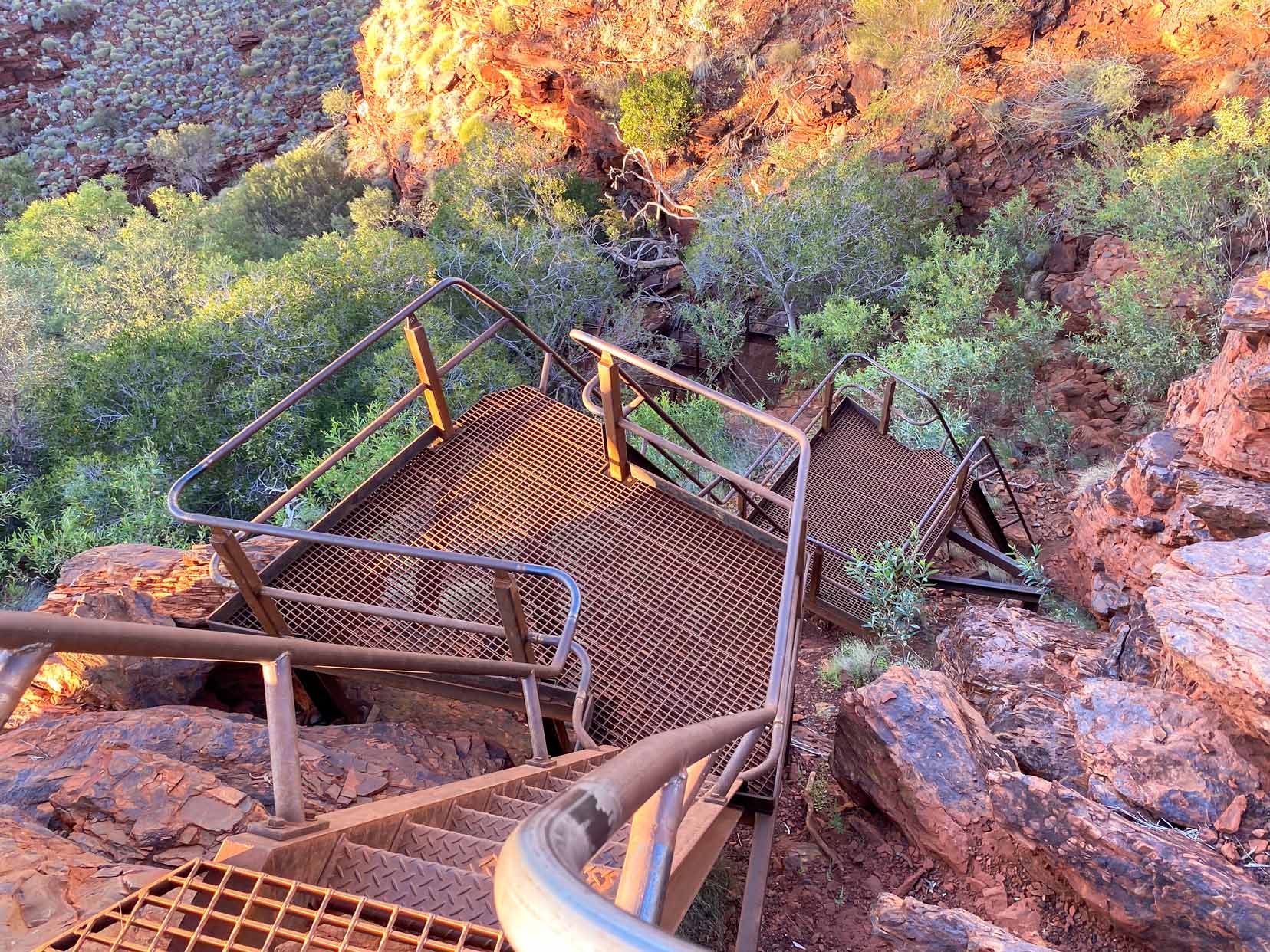
Once down, the trail quickly became a mix of rock scrambling and narrow passages, with the gorge walls towering above us, enclosing the path.
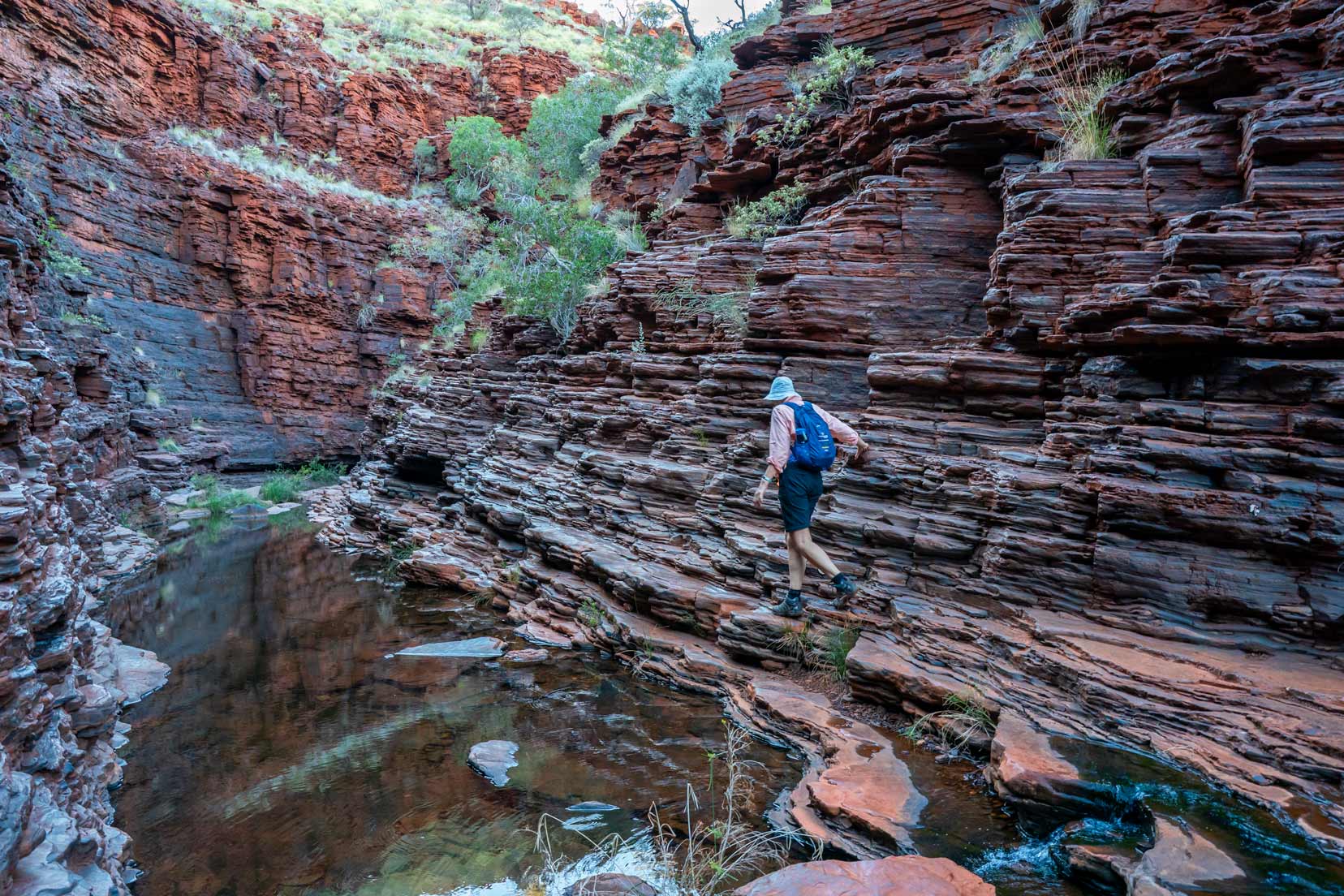
There were two sections of water that we needed to go through; the first, we could wade through, but the next, I swam through, and Lars managed to crawl along the rock face, being the Spiderman he is!
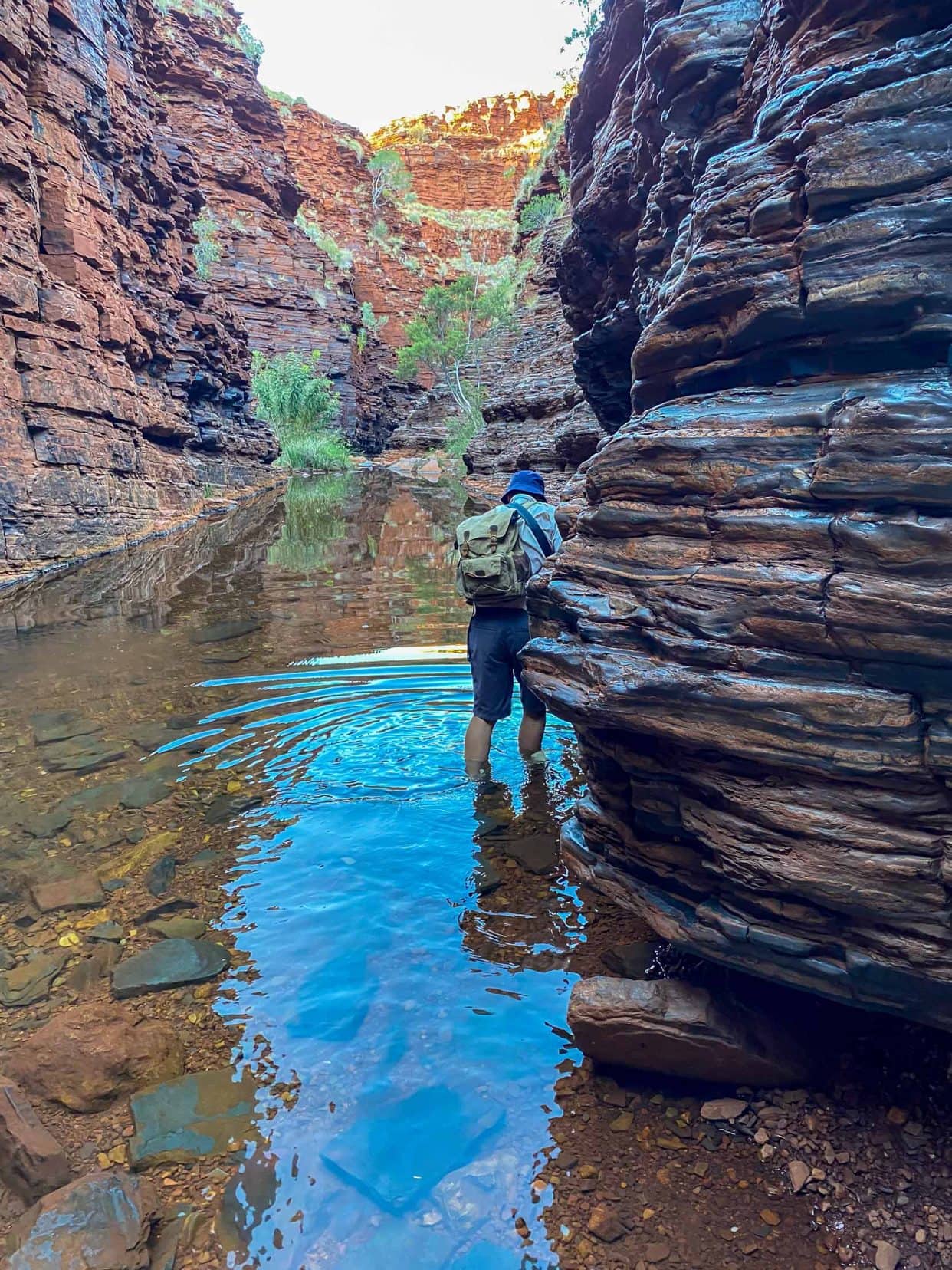
We should have left our bags and hiking shoes there and used water shoes for the next part. As it was, I swam through and decided not to go any further as the rocks were too slippery on the part leading to Kermits Pool.
I stayed in this pretty part where the rocks look like an amphitheatre.
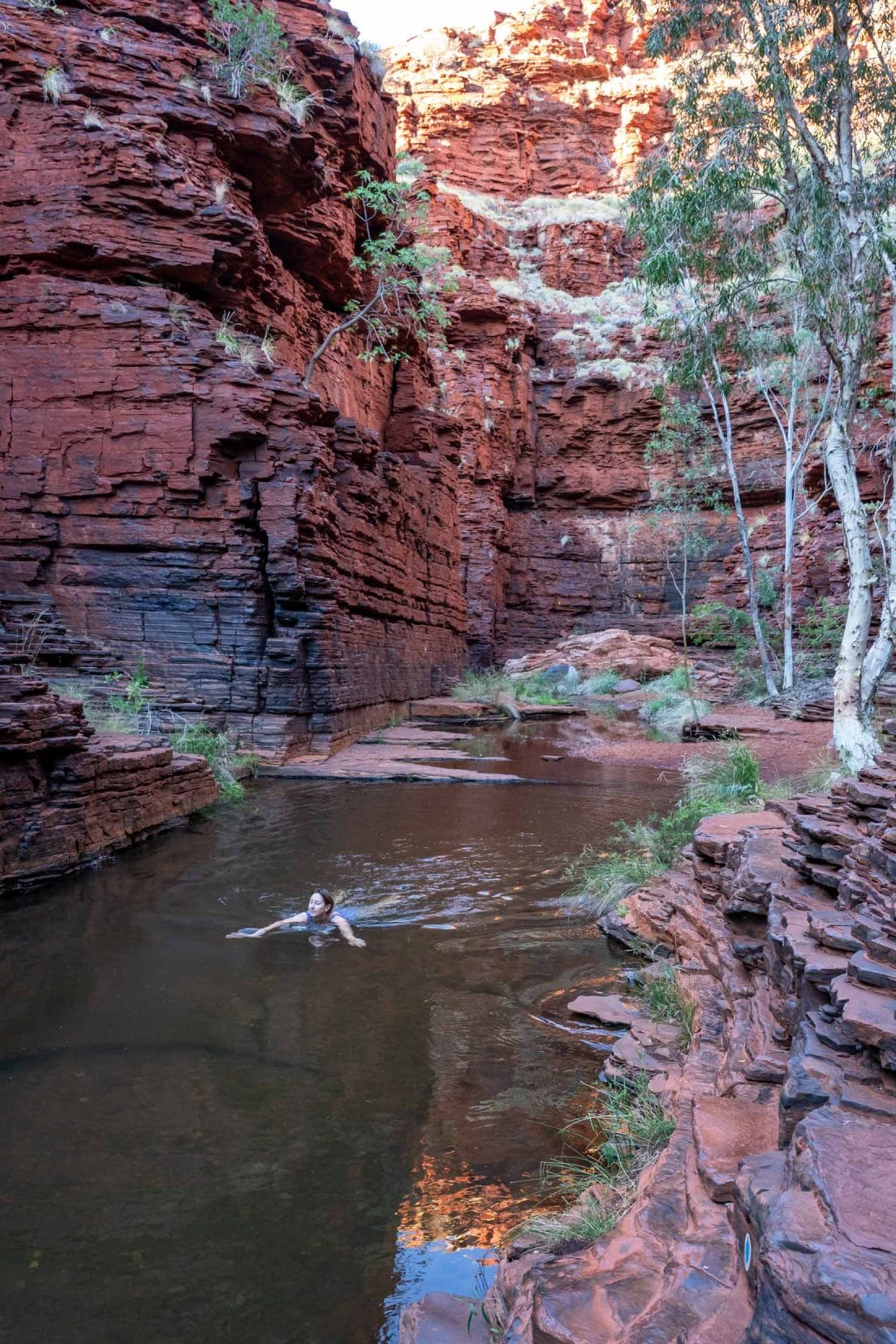
The part of the walk leading to Kermit’s Pool, involves a Spider Walk, best done with water shoes. The gorge then opens into the stunning Kermit’s Pool, a tranquil, jade-green swimming hole.
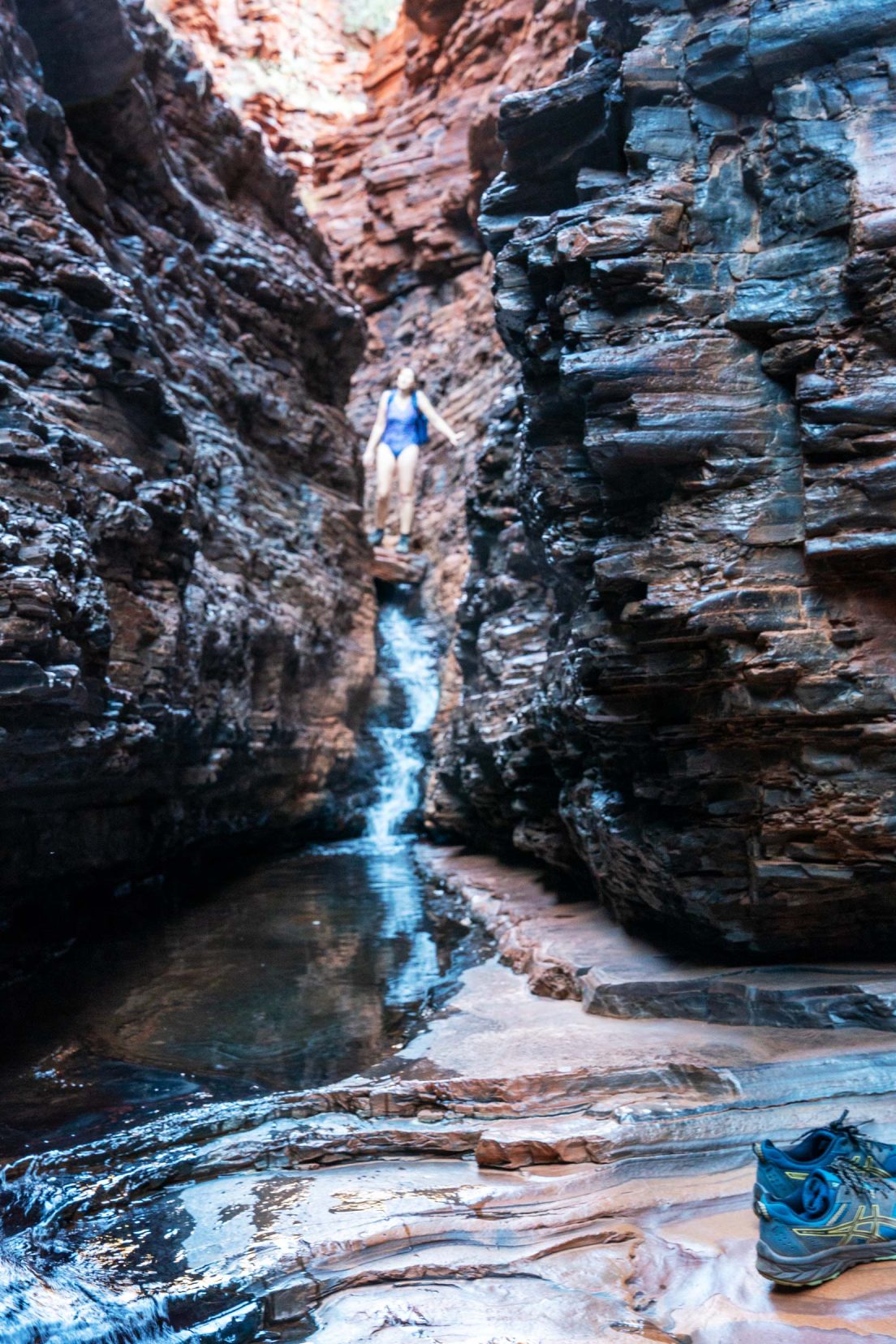
Lars managed to scramble along the rocks but then came a cropper when he slipped on the narrow section to Kermit’s Pool. He had a few bruises and a thumb that is still mending!
Nonetheless, he made it far enough to take the Kermit Pool picture.
Surrounded by ancient rock formations, the pool is an ideal spot to rest, cool off, and take in the natural beauty of Karijini.
We definitely could have done with our water shoes while attempting this hike!
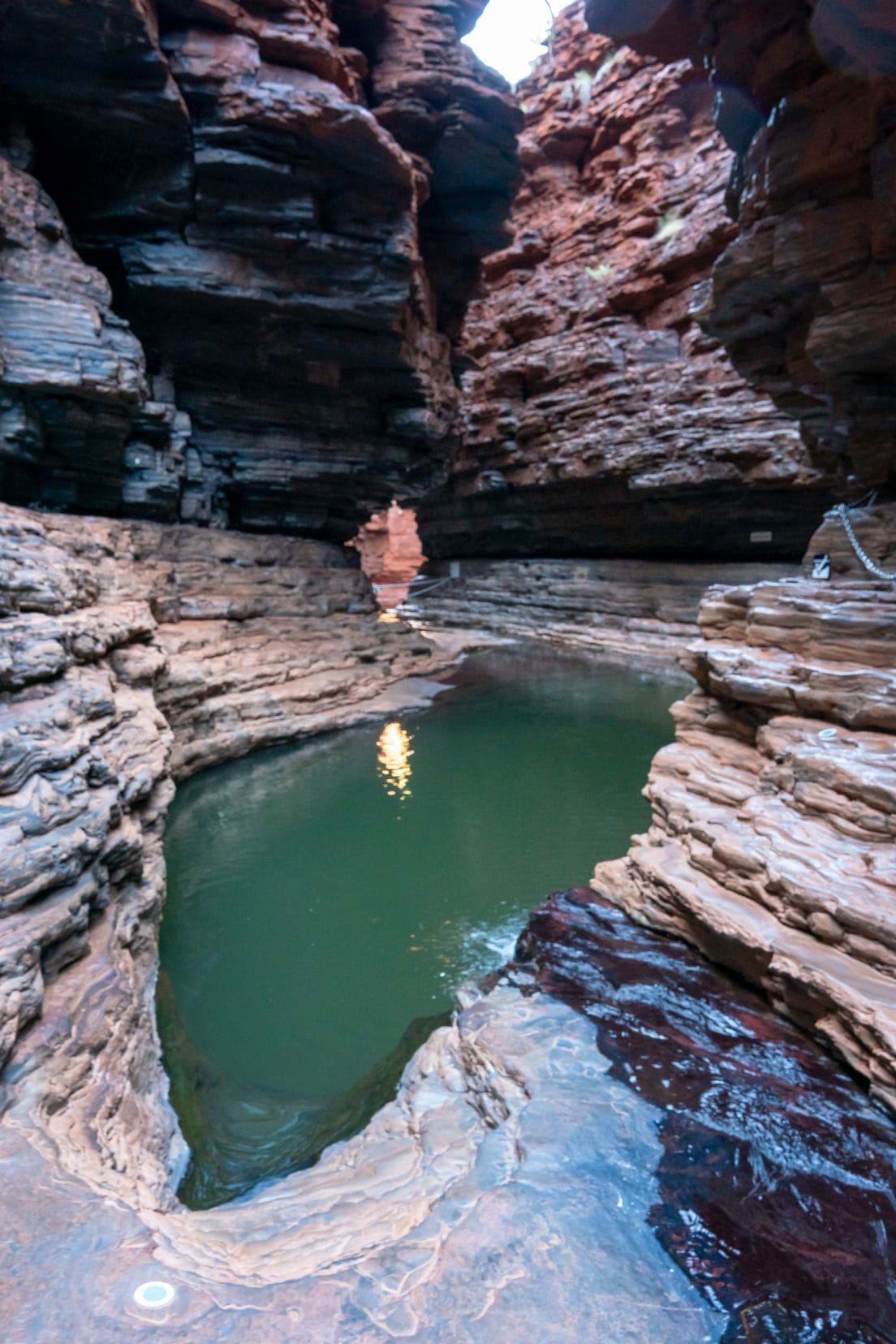
Weano Gorge
After completing Hancock, we moved on to Weano Gorge, a much easier trail than Hancock. The Upper Weano loop trail was open, though Lower Weano was closed due to a millipede infestation.
The trail is rated a level 4 difficulty and is about a 45-minute return hike.
If you had to miss one, then this gorge could be it. It is a more accessible gorge to hike, but the scenery wasn’t as spectacular as the other gorges.

Knox Gorge
Next, we went to Knox Gorge Lookout. It was heating up, and we decided that we had done enough hiking for the day.

The towering gorge walls and the vast expanse of the canyon make it worth the visit; even if you skip the entire hike, stop for a look at Knox.
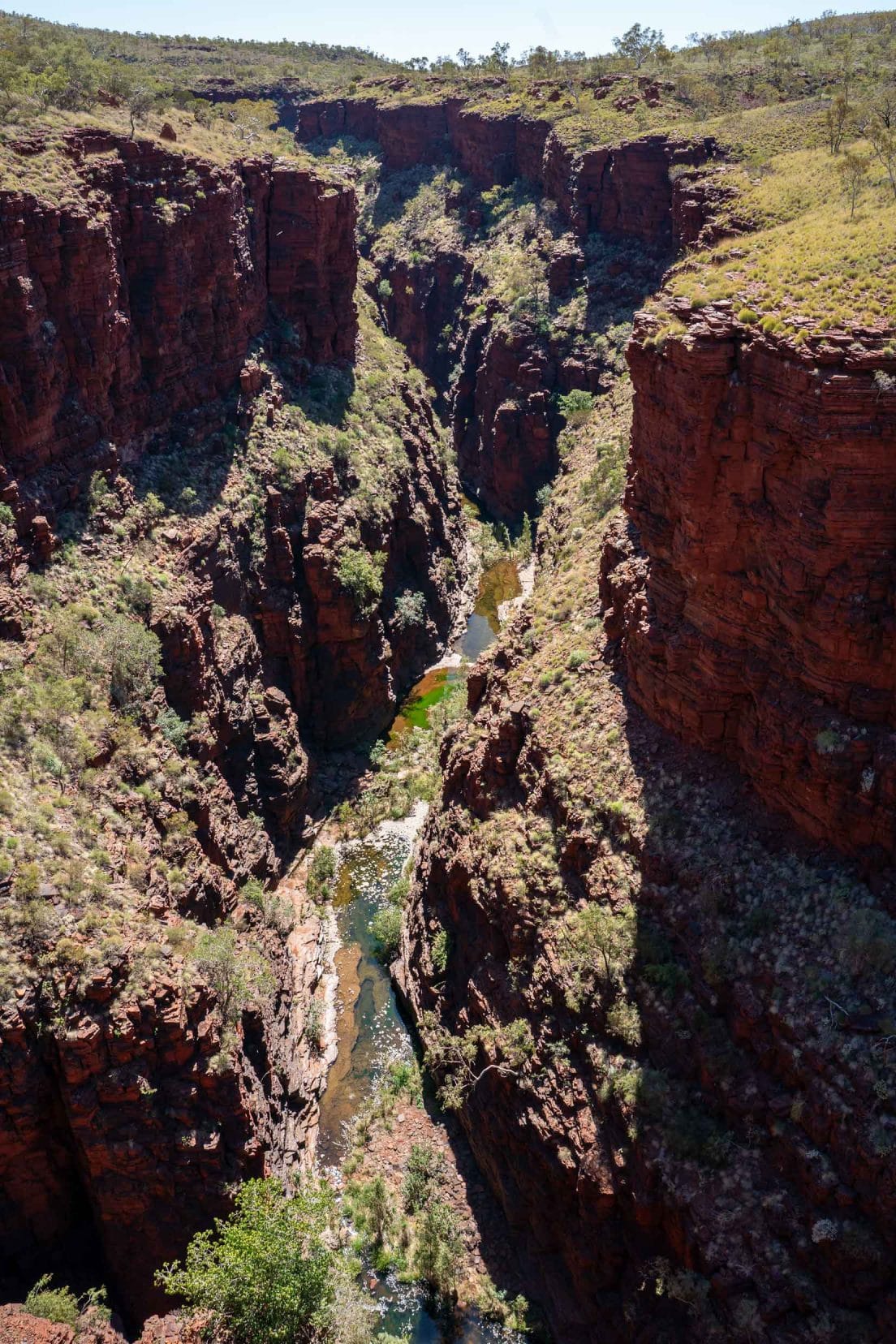
Others told us the hike was enjoyable, but the swimming holes were not as good as in other gorges. We’ll save this one for our next visit.
Joffre Gorge
To round off the day, we headed to the Joffre Gorge viewpoint stretching over the gorge. It offers dramatic views of the gorge and the many ladders on the other side that lead down into it.
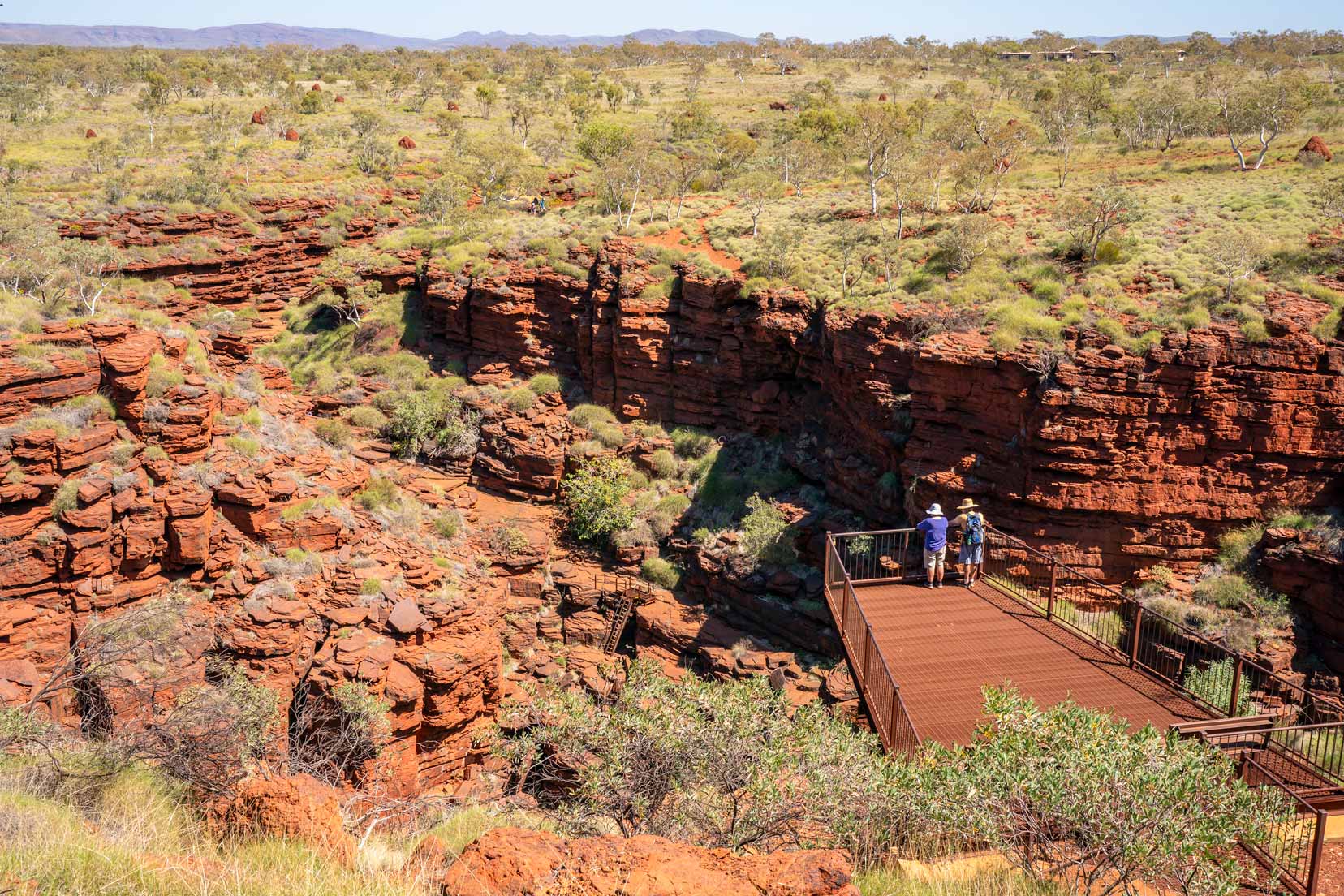
If you want to hike the gorge, you can easily do so by heading off from the Eco Retreat campsite. There is also a lookout on that side of the gorge too.
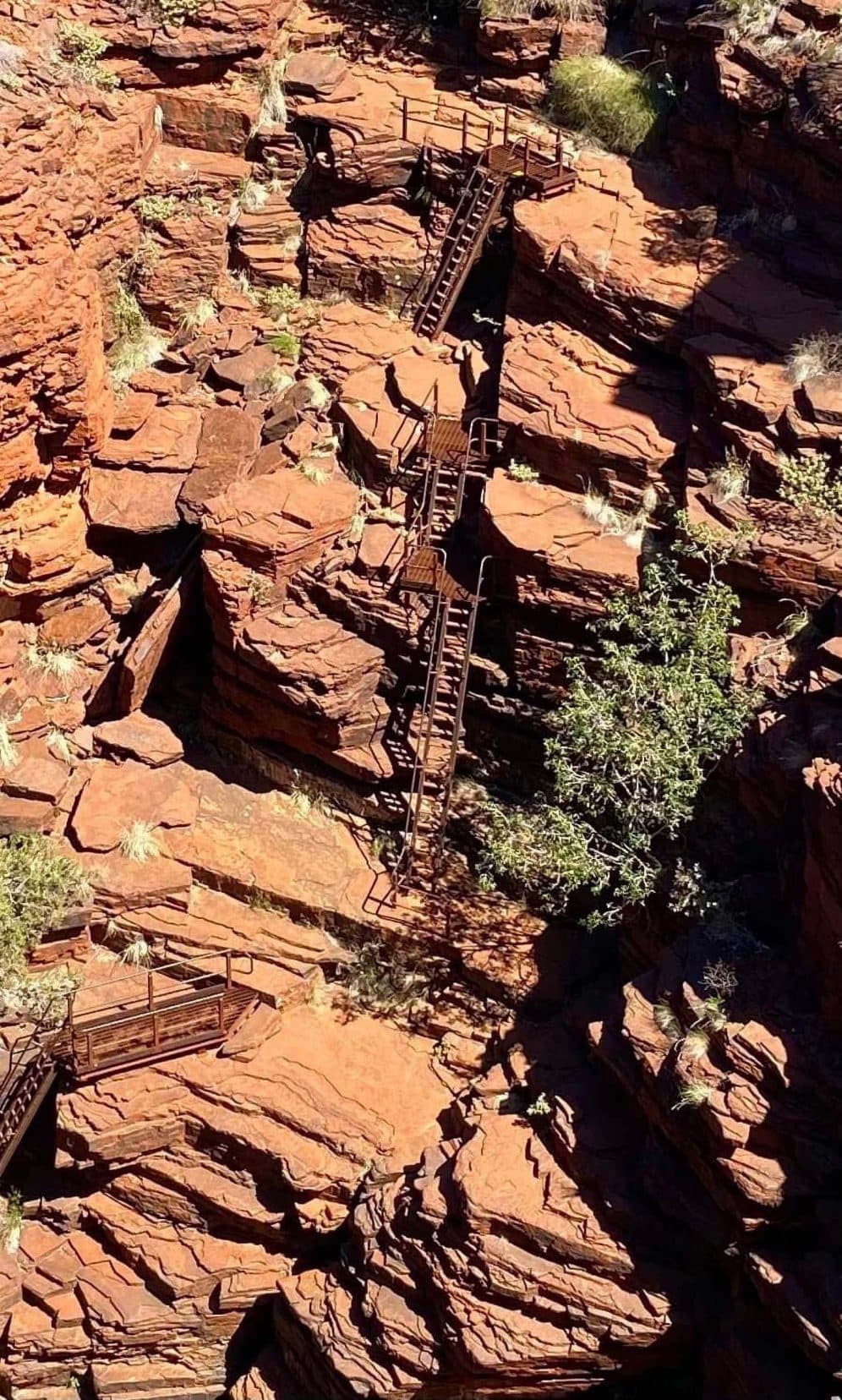
Karijini Visitor Centre
After a full day of hiking and exploring, we headed to the Karijini Visitor Centre to cool down, grab a much-needed ice cream, and pick up some water shoes for future hikes.
The Visitor Centre offers insights into the park’s geology, history, and Indigenous culture, with lots of interactive displays.
Visitor Tip: Start your hikes early to beat the heat, and bring water shoes for the more challenging hikes, especially Hancock Gorge. Tackling all these in one day requires stamina, but the diverse scenery makes it worthwhile.
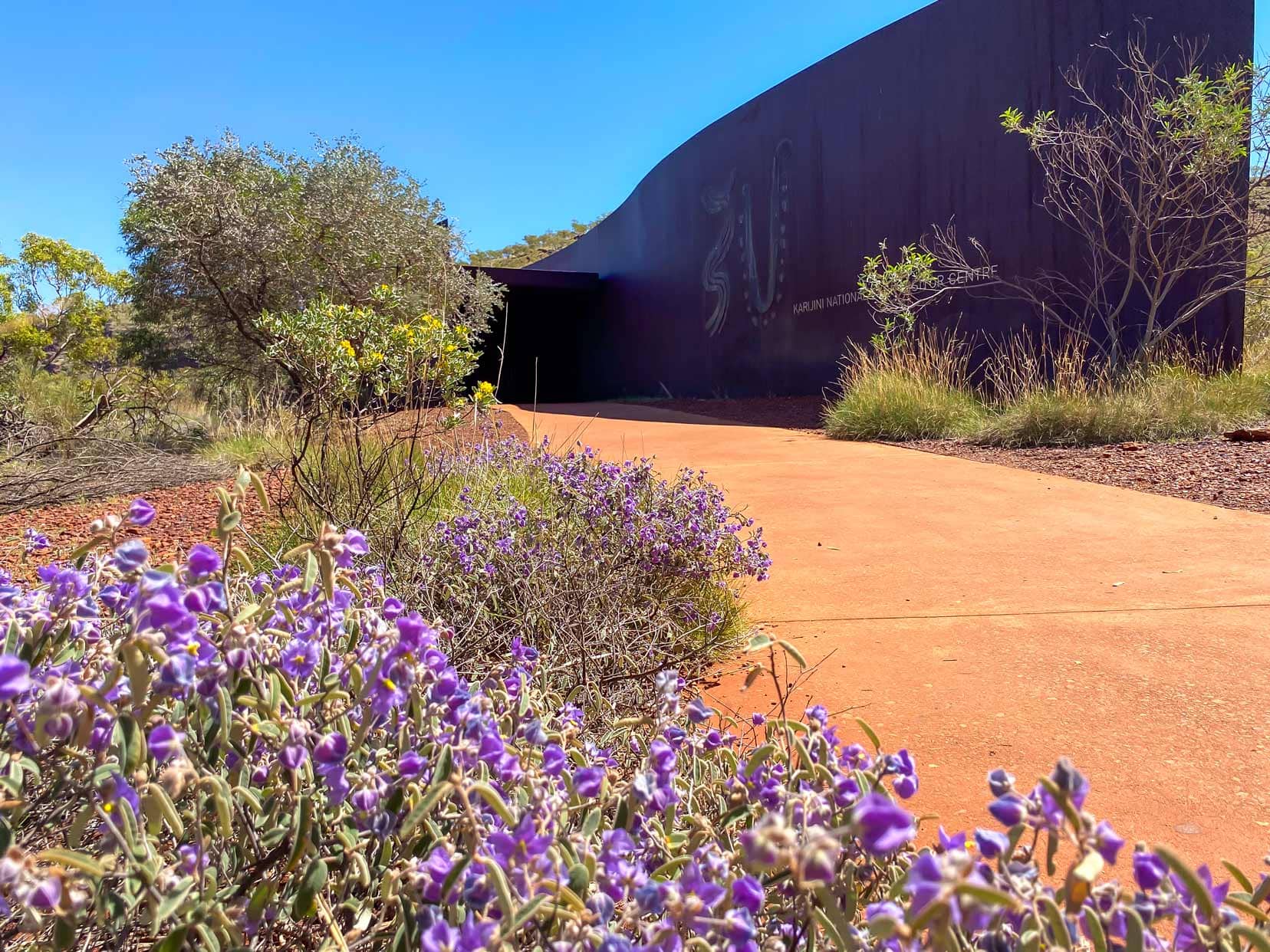
Where to Stay: Karijini Eco-Retreat
The Eco-Retreat is near Joffre, so you can walk from the camp to the gorge.
Day 4: Discovering the Serene Beauty of Kalamina Gorge
Kalamina Gorge became one of our favourite spots in Karijini. Arriving just after sunrise at 7 am, we had the entire gorge to ourselves, bathed in the soft, golden morning light that brought out the natural beauty of the surroundings.
The hike is a Grade 4 trail, mostly flat except for the initial descent into the gorge. As we followed the winding path, we came across a series of small waterfalls and picturesque pools, the largest of which lies just at the bottom of the steps.
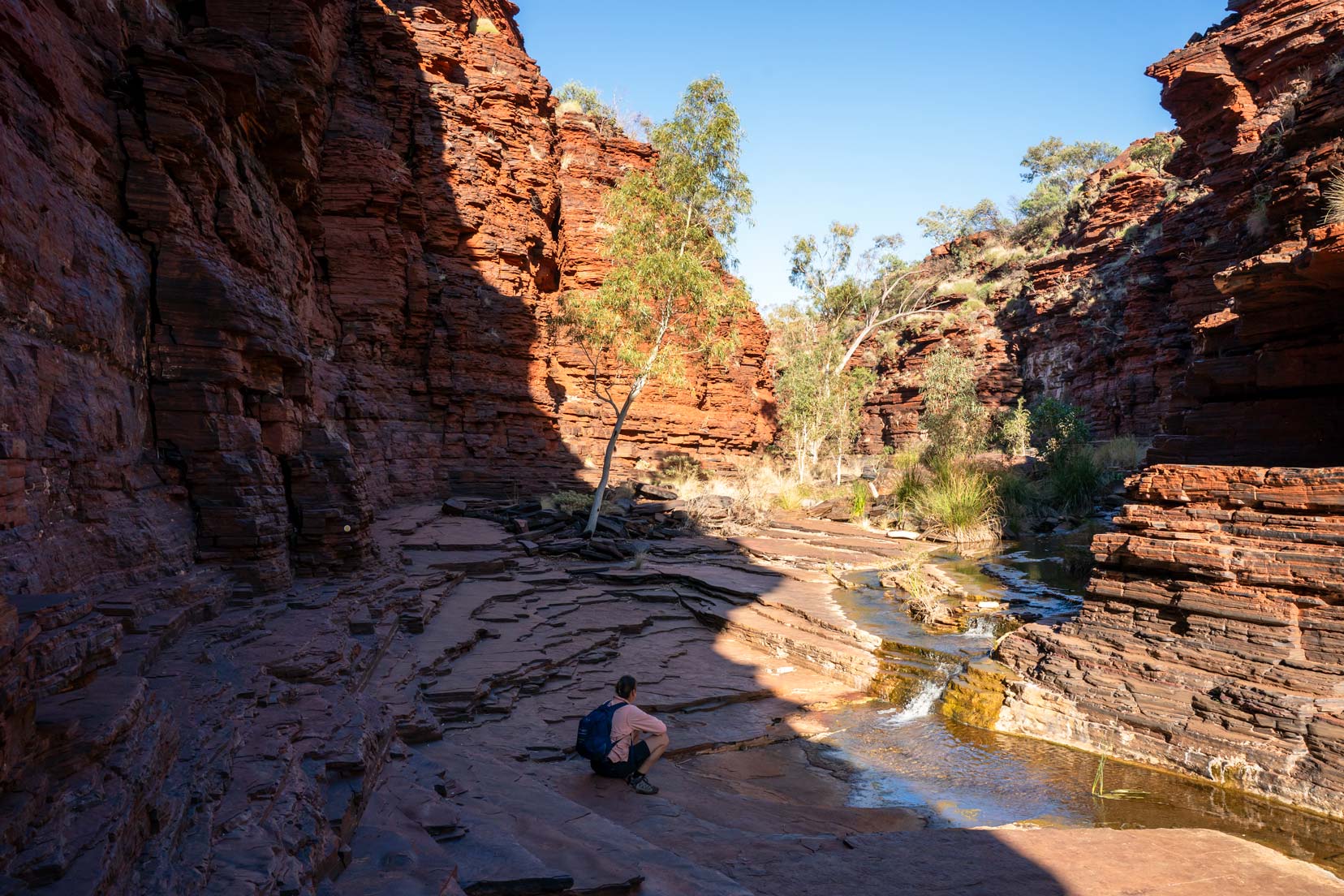
The water’s clarity created perfect mirrors of the striking orange rock walls and overhanging trees, offering plenty of photo-worthy moments.
As we ventured further, each twist in the trail revealed new pools and rock formations, each as captivating as the last. Near the trail’s end, a small sign marked our accomplishment, and we couldn’t resist swimming in the gorge’s icy waters.
After the initial chill, floating between towering ancient rock formations was refreshing and awe-inspiring.
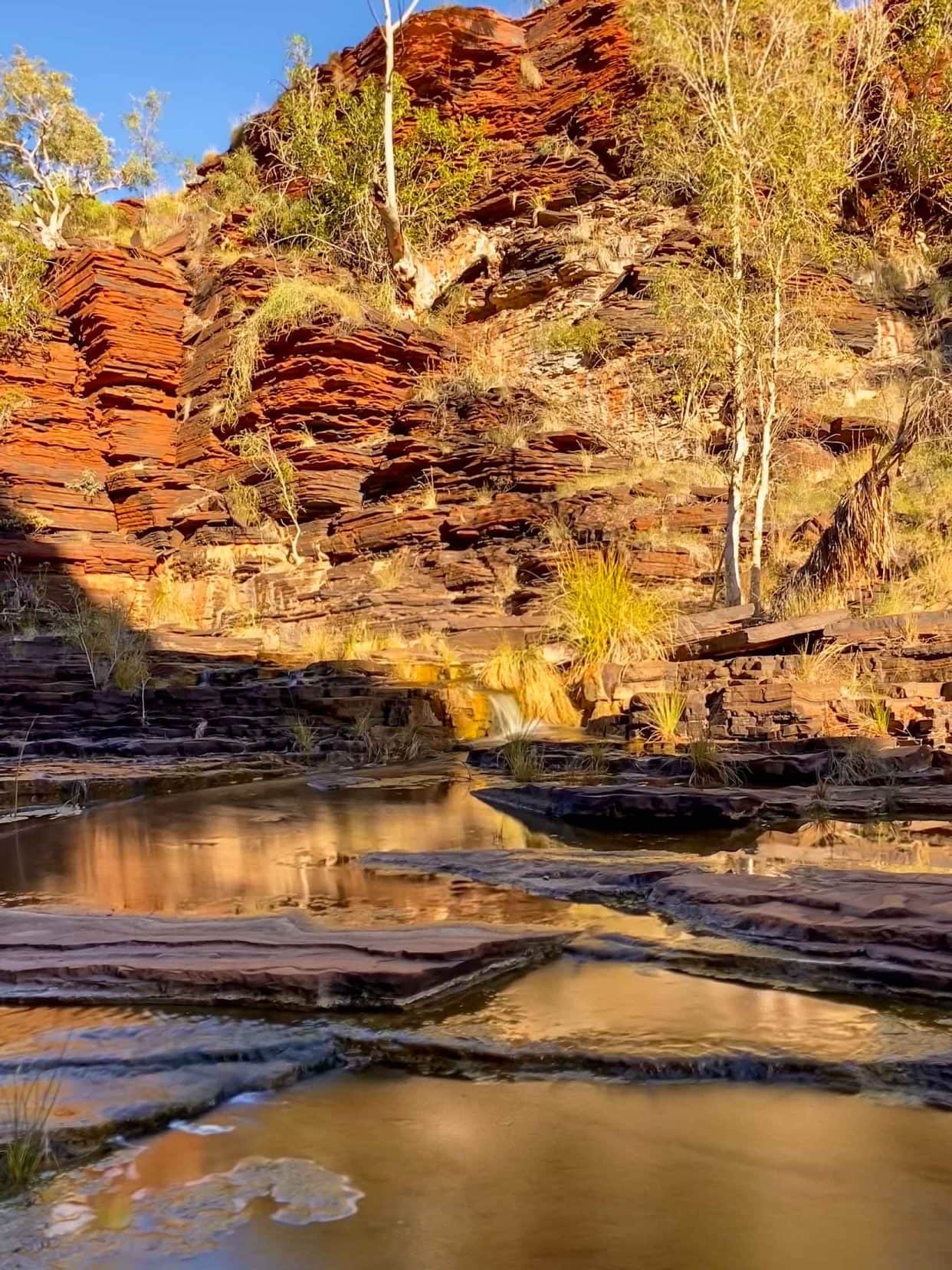
On our return, we bumped into a friendly couple and spent some time chatting and sharing our travel experiences. By mid-morning, more visitors had started to arrive, and the sunlight became stronger, casting a different light on the gorge.
We were also treated to a dance of butterflies and dragonflies as they flitted about, adding a final touch of magic to the scene.

Pro Tip: Visiting early ensures you beat the crowds and allows you to capture the best light for photographs. The early morning atmosphere adds a unique charm to the gorge.
👉 Check out our Kalamina article for a detailed look at hiking Kalamina Gorge.
Where to Stay: Dales Campground
Dales Campground is within walking distance of Dales Gorge but has limited facilities – drop toilets only.
Day 5: Dales Gorge and Fortescue Falls
On our final day, we explored Dales Gorge, starting with an early hike down the 250 steps to Fortescue Falls. The walk down is easy, with rest points where you can stop and take in the views.
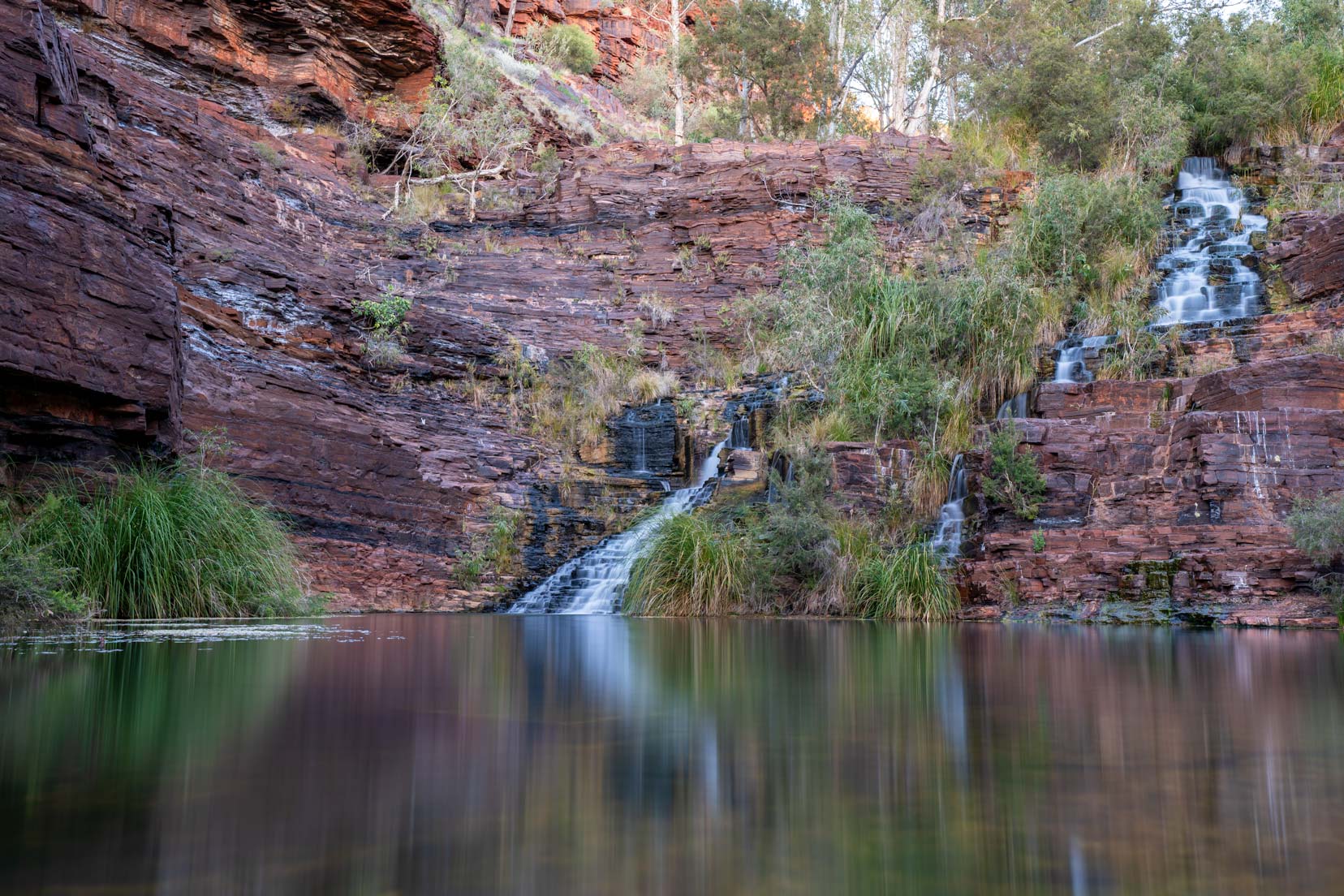
Once at the bottom, we took a short path (300m) to Fern Pool, where, on the way, we were greeted by the sound of flying foxes roosting in the trees.
Fern Pool was a serene spot for a morning swim, with warm, inviting waters and a small waterfall at the far end.
The pool is an important part of the Aboriginal culture. Known as Jubura, Dreamtime Stories tell us that the pools here were created by giant serpents and that the spirit of the serpents lives on in Fern Pool (Jubura). Signs at Fern Pool encourage you to respect this and to avoid loud noises here.
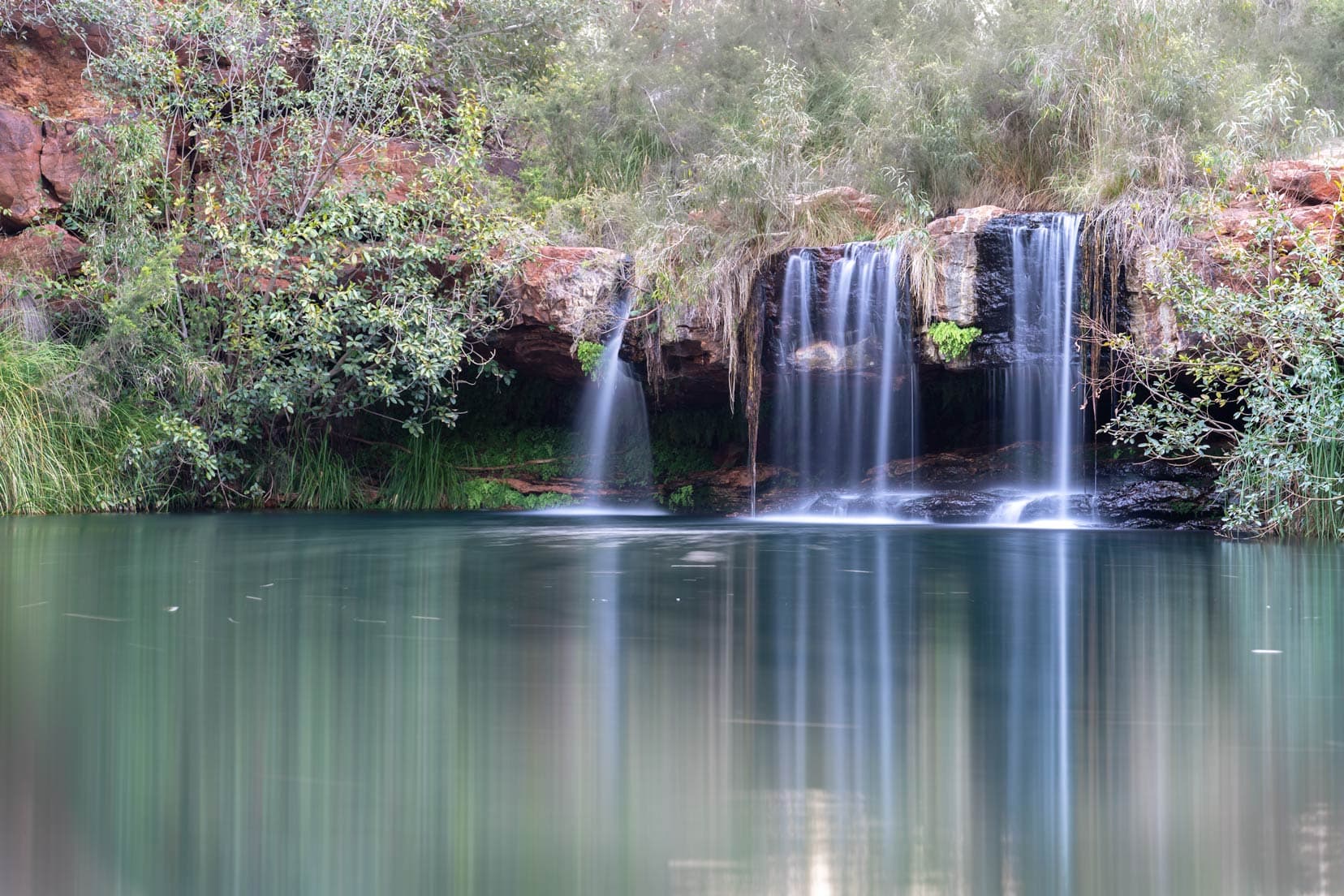
We also took on the Dales Gorge Rim Walk, offering spectacular views from above. The walk eventually leads down into the gorge, allowing you to loop back to Fortescue Falls and Fern Pool.
Pro Tip: Arrive early to avoid the crowds at Fern Pool and enjoy the peacefulness of Dales Gorge.
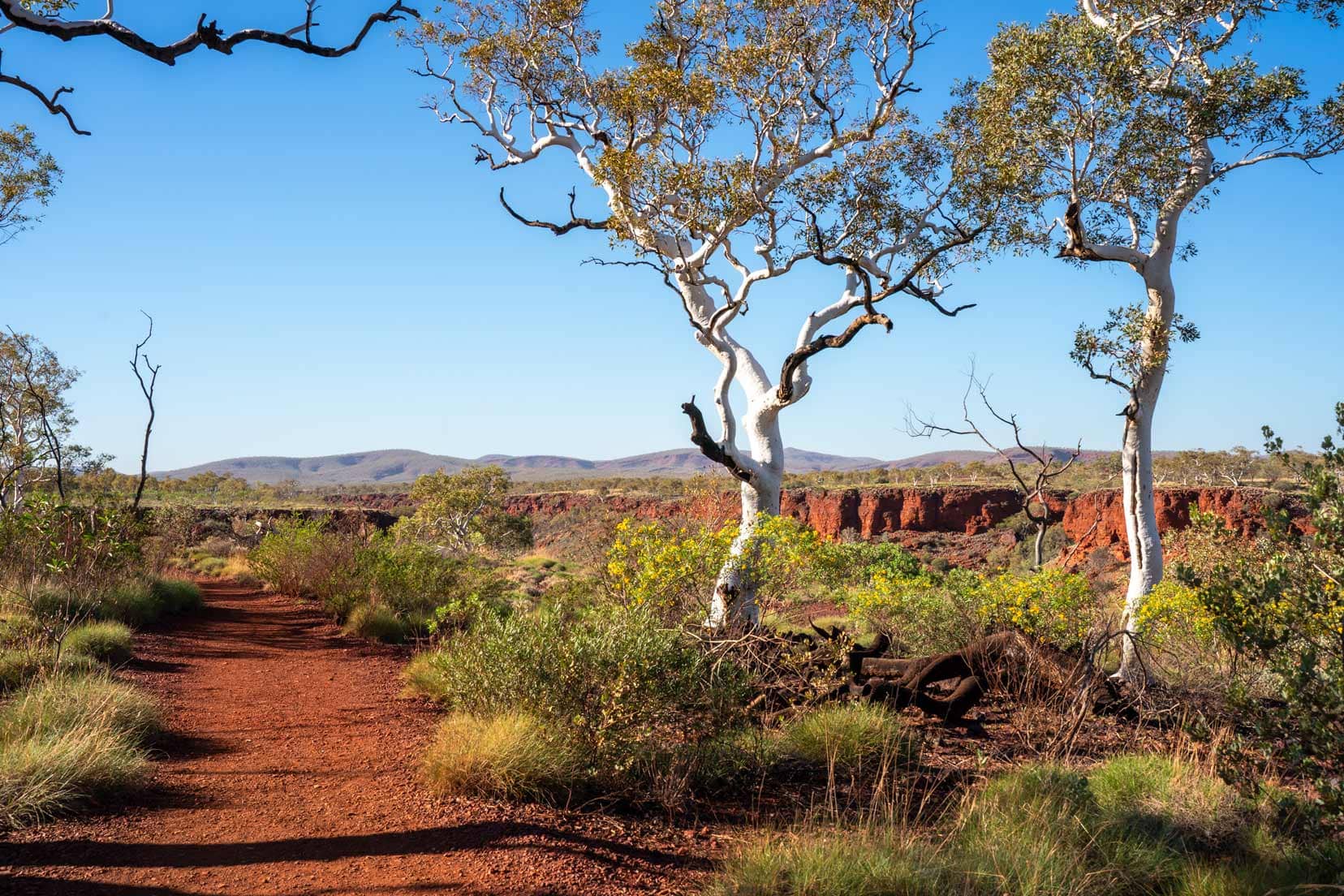
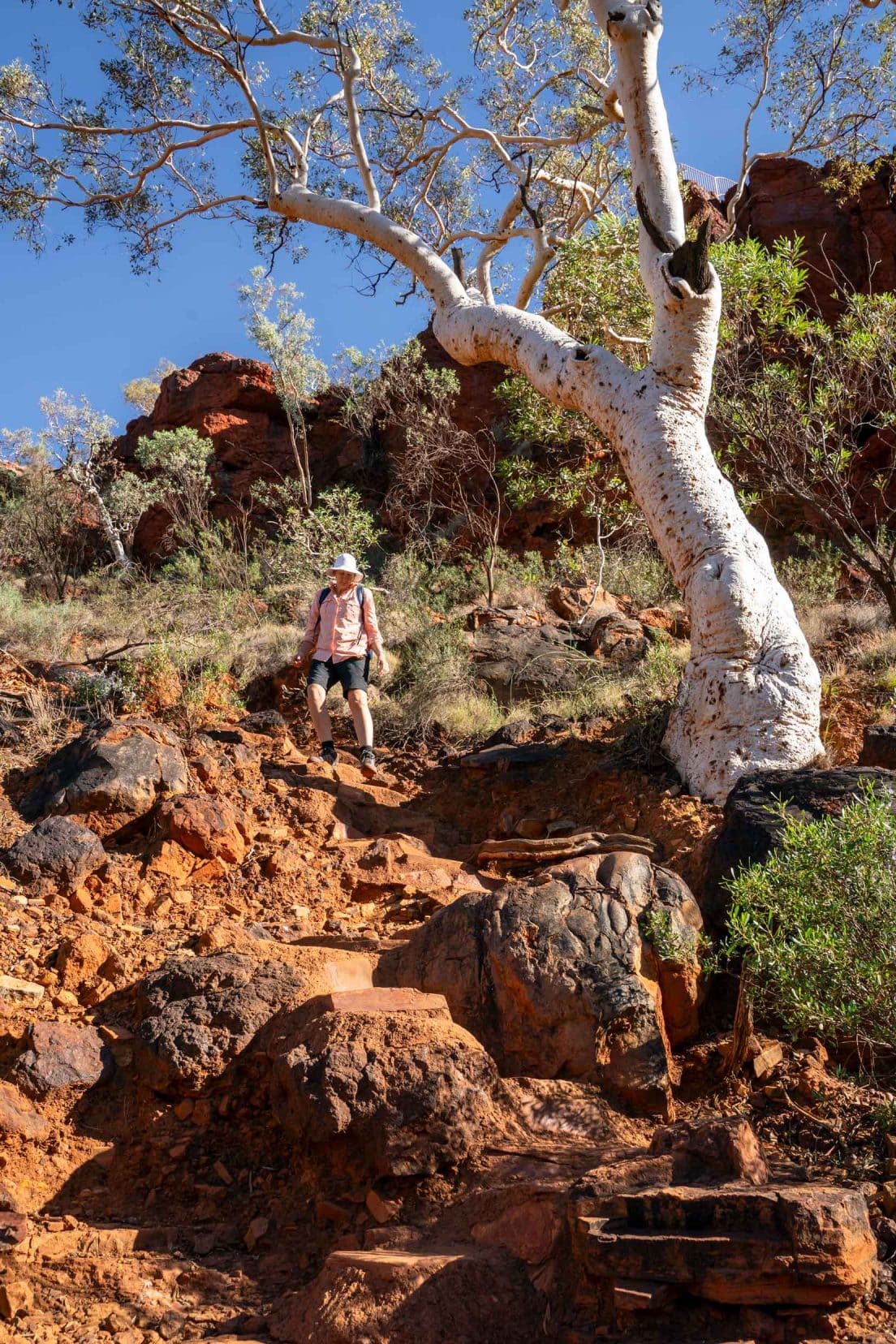
Where to Stay: Dales Campground
Dales is the most convenient camping site for Dales Gorge, Fortescue Falls, and Fern Pool.
Lookouts for Visitors with Limited Mobility
If hiking the gorges isn’t feasible, don’t worry—Karijini still offers several scenic lookouts that provide breathtaking views without the need for strenuous hiking. These are perfect for those with limited mobility:
- Knox Gorge Lookout: Offers dramatic views of the gorge from above, showcasing its narrow, steep walls.
- Joffre Gorge Lookout: Provides a stunning perspective of the waterfall and natural amphitheatre formed by the rocks.
- Oxer Lookout: One of the most famous lookouts in the park, Oxer Lookout sits at the junction of four gorges—Weano, Red, Hancock, and Joffre. The expansive view from here is one of Karijini’s most iconic sights, offering a breathtaking view over the rugged landscape.
- Dales Gorge Rim Walk: A relatively easy walk along the edge of Dales Gorge, offering panoramic views of the gorge and the flowing water below.
These lookouts ensure that everyone can experience the beauty of Karijini, even without descending into the gorges.
Even if you plan to hike, the lookouts are well worth visiting for the best panoramic views of the gorges.
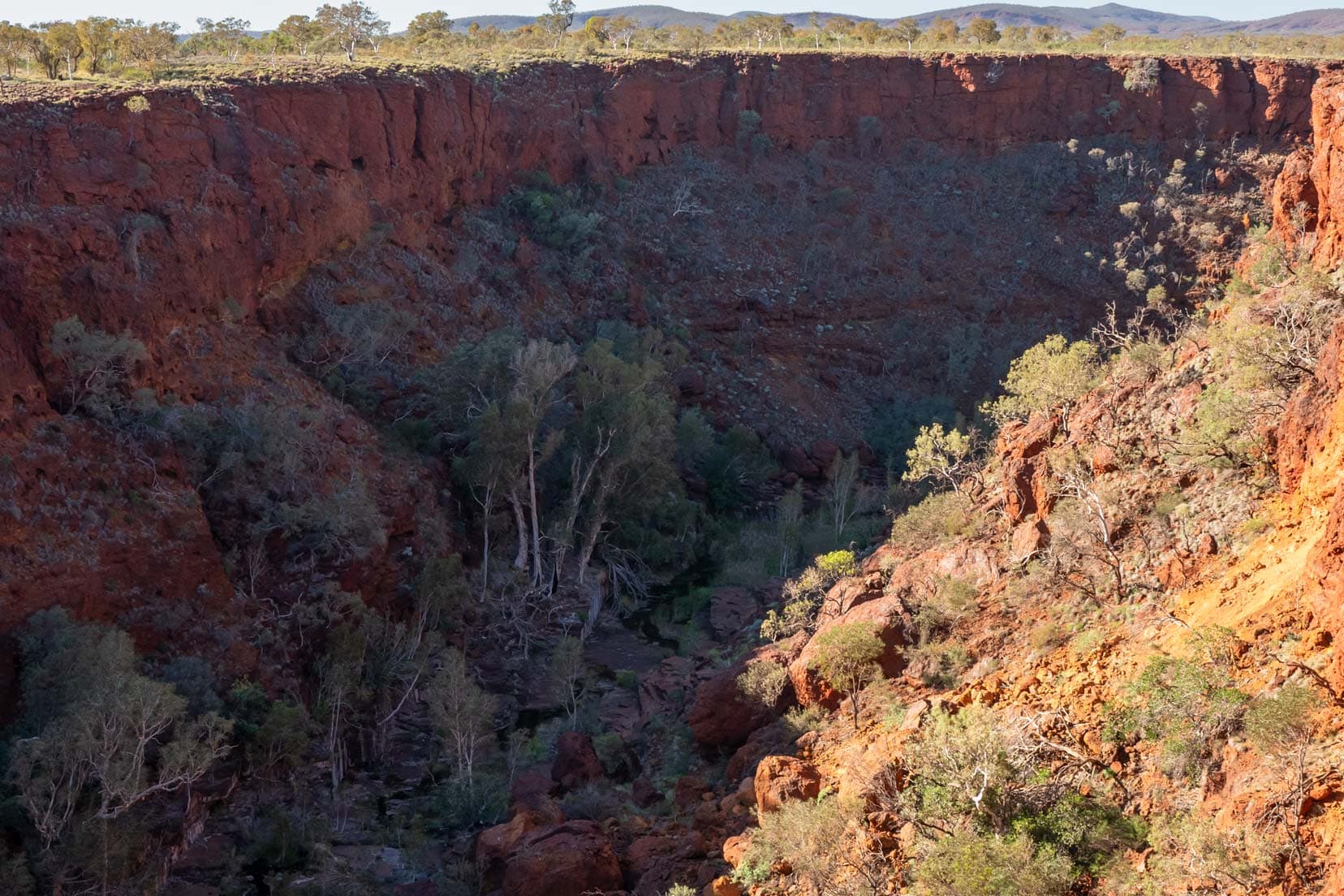
What is the Best time to Visit Karijini?
The cooler months, from April to September, are ideal for visiting Karijini National Park. Daytime temperatures are mild, making hiking and exploring more comfortable. Avoid the extreme heat of summer (December to February).
During the summer months, Karijini can be subject to flash flooding and cyclones. Therefore, it’s not a good time to visit. The Visitor Centre also closes for 6-9 weeks from mid-December.
We visited at the beginning of September, and it was starting to get very hot – not ideal for hiking, but great for using the gorge pools. We began our hikes early, but you could spend more of the day exploring the gorges in cooler weather.
Wildflowers were blooming, including lots of purple mulla mulla.
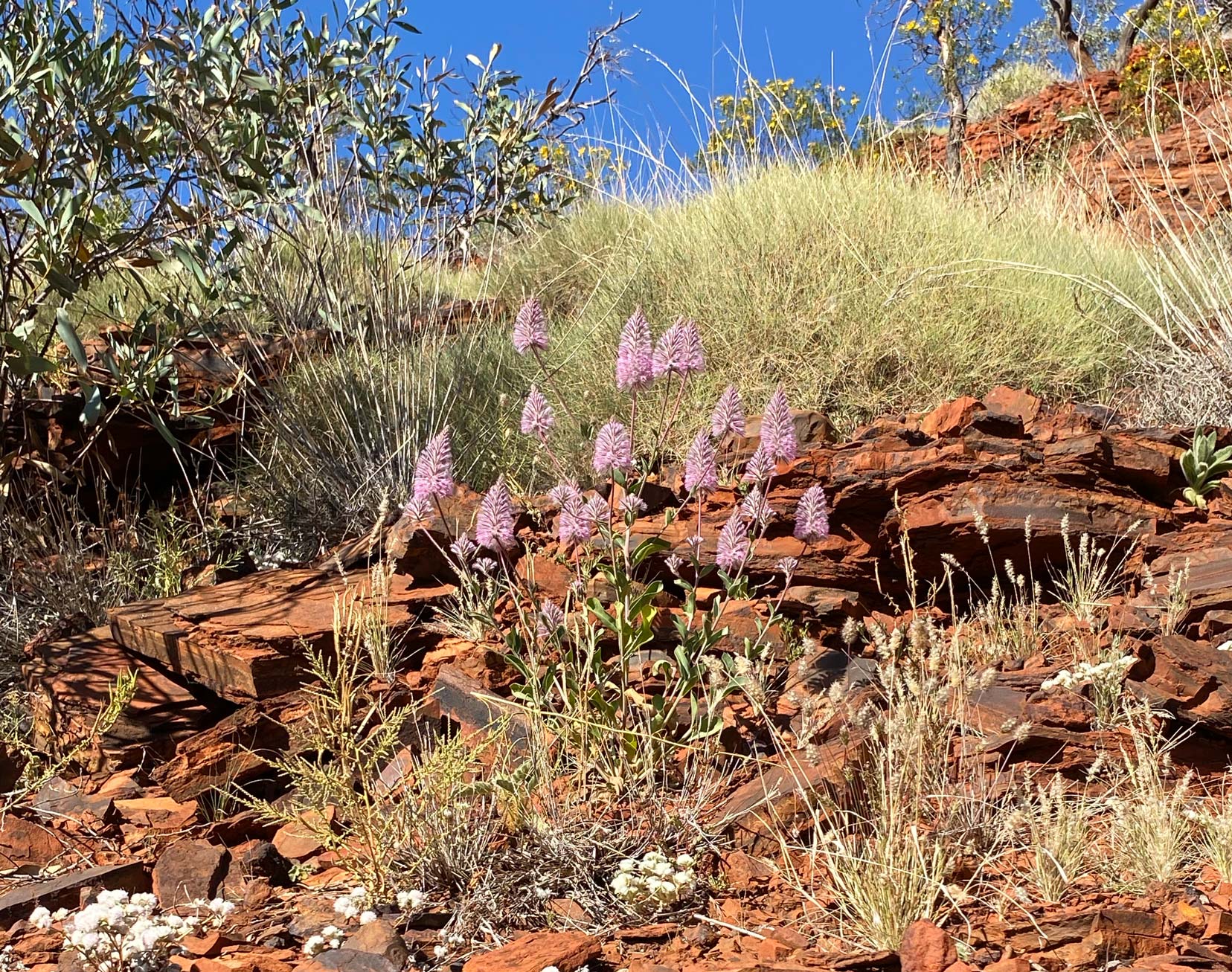
Best Photography Spots in Karijini
Karijini’s dramatic landscapes make it a dream destination for photographers. Here are some of the best spots to capture:
- Spa Pool in Hamersley Gorge: The unique, layered rock formations around Spa Pool create stunning compositions, particularly in the early morning light.
- Fern Pool, Dales Gorge: Capture the peaceful reflections in Fern Pool with the waterfall and surrounding greenery, creating a natural frame.
- Kalamina Gorge: The still water in Kalamina Gorge mirrors the vibrant orange rock walls, making for an incredible reflection shot.
Pro Tip: The best light for photography is early morning or late afternoon when the sun casts a golden glow on the gorge walls and pools.
For more tips on capturing those perfect moments, check out our Road Trip Photography guide for photo ideas.
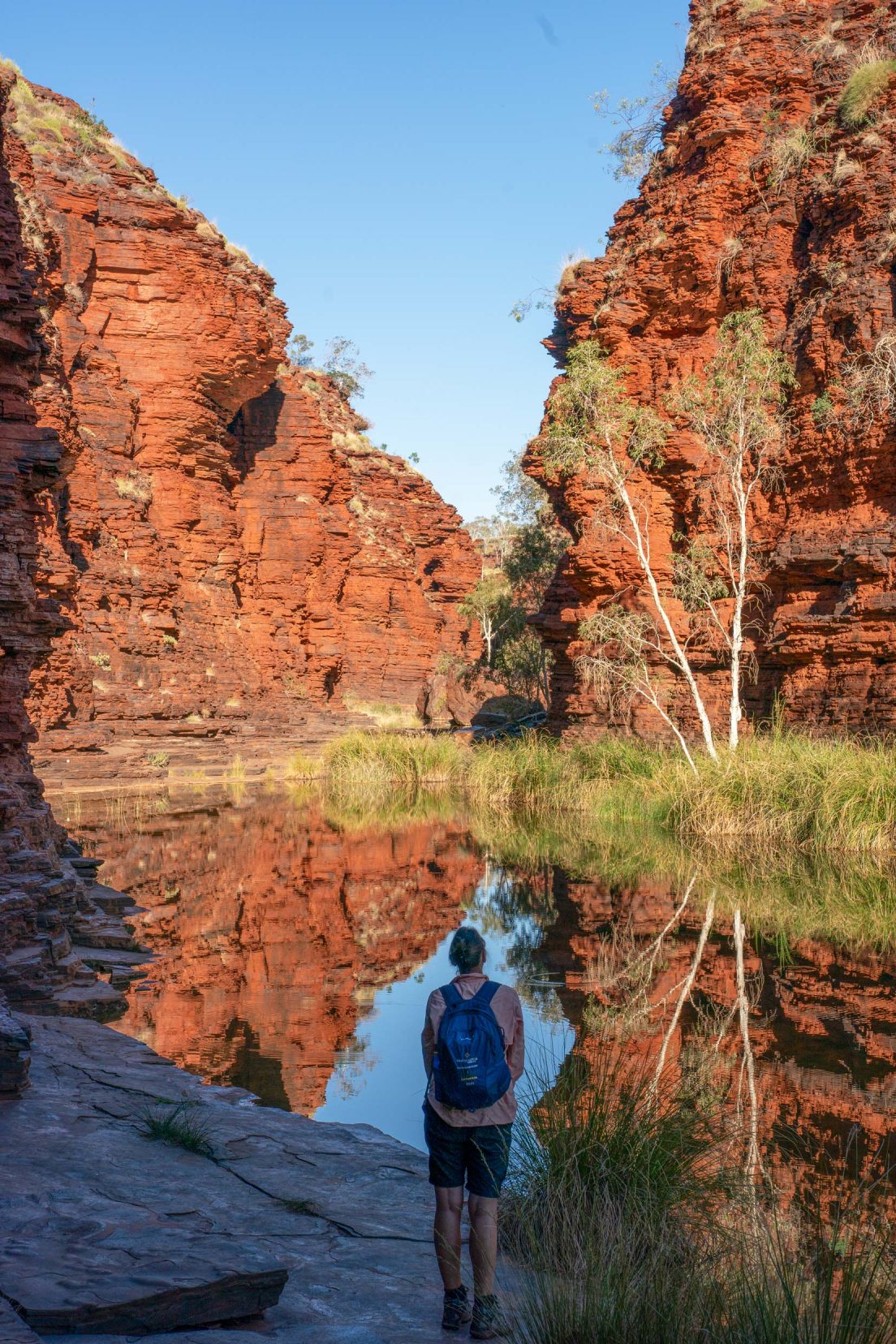
How to Get to Karijini National Park
By Air:
Paraburdoo Airport is the closest airport to Karijini National Park, about 130 km away. Qantas offers daily flights from Perth to Paraburdoo, making it the most convenient option for visitors travelling by air.
Car Hire:
Once you arrive at Paraburdoo, renting a car is the easiest way to explore Karijini. Car hire services are available directly from the airport, allowing you to navigate the park and nearby attractions at their own pace.
👉 Book your car hire with Discover Cars for great deals and a wide selection of vehicles suited for both 2WD and 4WD tracks in Karijini.
If you’re driving from Perth, the journey is approximately 1,400 km and takes around 15 hours. Many visitors make it part of a more extensive road trip, stopping at attractions like the Ningaloo Coast or Mount Augustus inland.
READ MORE: Our Extensive Road Trip from Perth to Karijini
Explore more of WA beyond Karijini in our Explore Western Australia Guide, packed with tips and destinations.
Key distances to note:
- Tom Price (the closest town to Karijini) is around 70 km from the park, where you can stock up on supplies.
- Exmouth is roughly 640 km northwest, ideal for combining Karijini with Ningaloo Reef.
Planning a road trip through Western Australia? Here’s our guide on How to Plan a Road Trip to help you prepare.
Road Conditions:
Most of the park’s roads are sealed and accessible with a standard vehicle, though a 4WD is recommended for some of the unsealed roads leading to gorges like Kalamina and Hamersley.
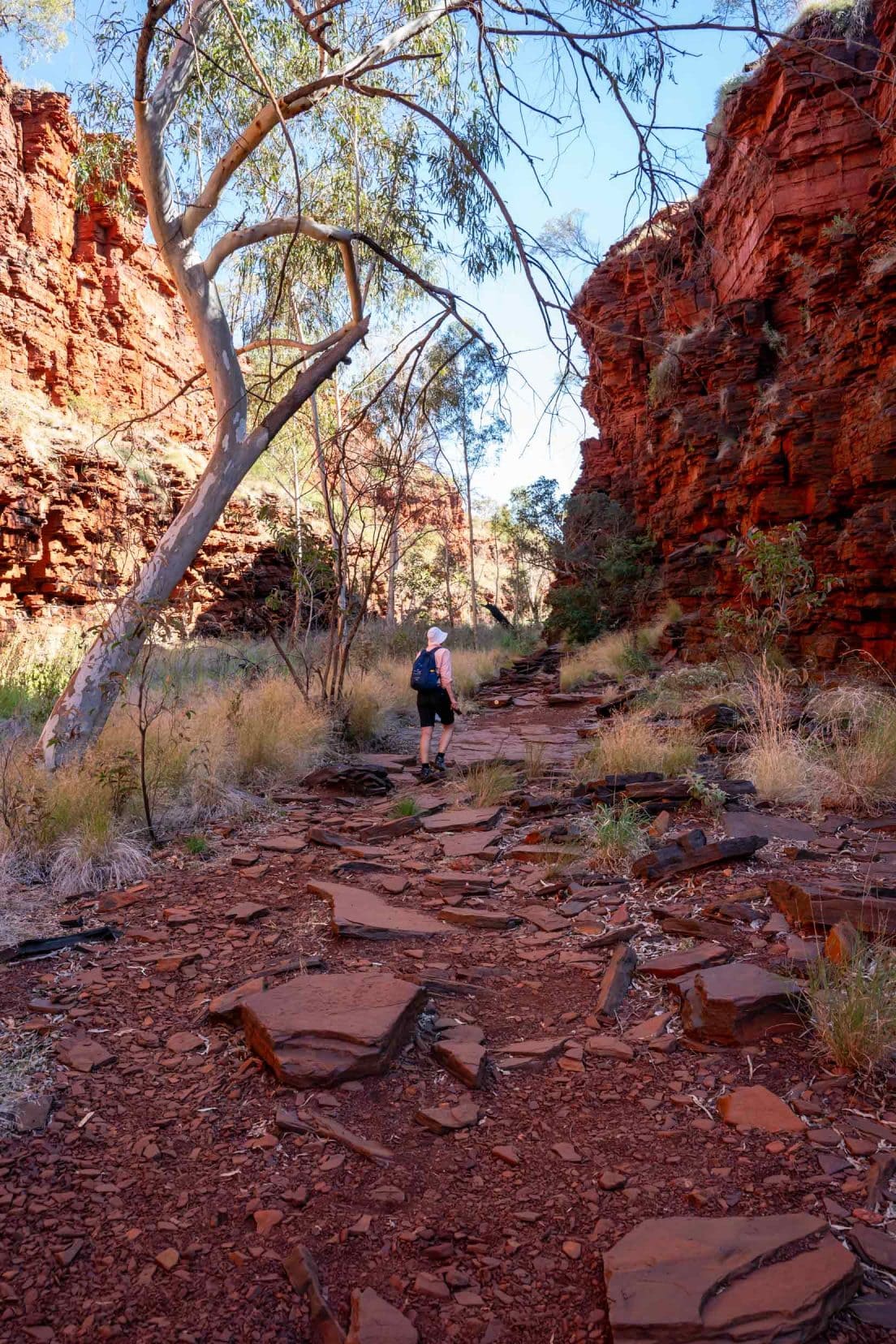
For those wanting to explore Karijini in comfort, we recommend hiring a motorhome from Motorhome Republic.
Safety Tips for Hiking in Karijini Gorges
Karijini National Park is a stunning but remote wilderness, and safety should always be a top priority when hiking its gorges. Here are some essential tips to help you enjoy your adventure safely:
1. Stay Hydrated
The Pilbara region can get extremely hot, especially during the summer months. Always carry plenty of water—at least 5 litres per person per day is recommended—and take regular sips to avoid dehydration.
Pro Tip: There are no drinking water facilities in the gorges, so be sure to pack enough before heading out.
2. Wear the Right Footwear
The gorges often have uneven, slippery rocks, and in some cases, you’ll be walking through water. Proper hiking shoes with a good grip are a must, and for gorges like Hancock Gorge, water shoes are recommended to navigate slippery sections.
Pro Tip: The Visitor Centre sells water shoes if you forget to pack them.
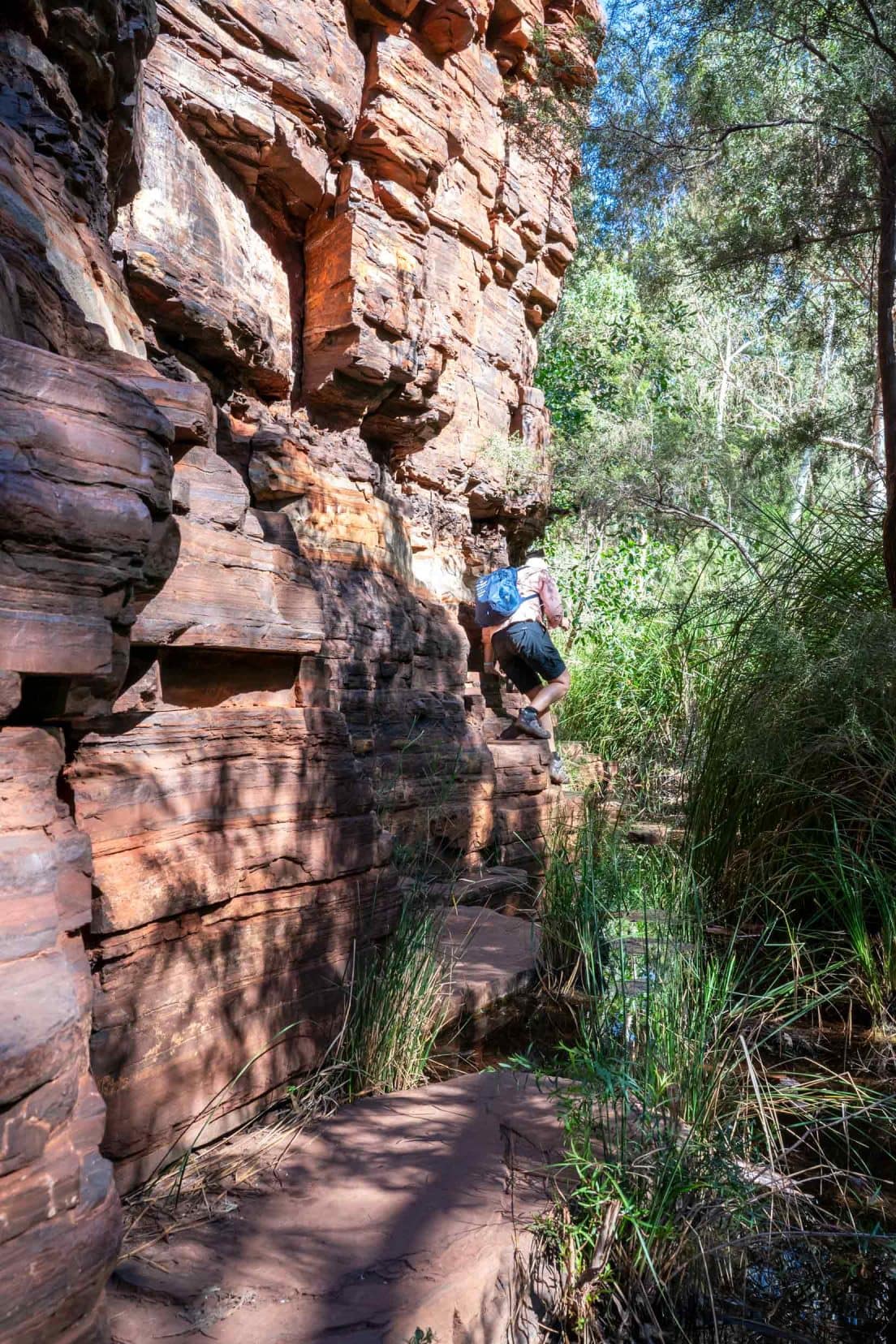
3. Check the Weather
Flash flooding can occur during the rainy season, making some gorges dangerous. Always check the weather forecast and speak to the Karijini Visitor Centre for updates on trail conditions before setting out.
Pro Tip: Avoid entering the gorges if rain is forecast, as water levels can rise quickly. If it starts to rain while in the gorge, leave immediately.
4. Know Your Limits
Some gorges, like Hancock and Knox, are classified as Grade 5 hikes, requiring high fitness levels. If you’re not experienced with scrambling or swimming through narrow, rocky terrain, it’s best to choose easier trails like Dales Gorge or Kalamina Gorge.
Pro Tip: For each trail, allow extra time to complete the hike and always carry a Personal Locator Beacon (PLB) for emergencies.
5. Start Early
The best time to hike is early morning to avoid the heat and crowds. Most gorges offer little to no shade, so it’s essential to get started at sunrise if possible, especially during the hotter months.
Pro Tip: Early mornings also provide the best light for photography and a quieter, more serene hiking experience.
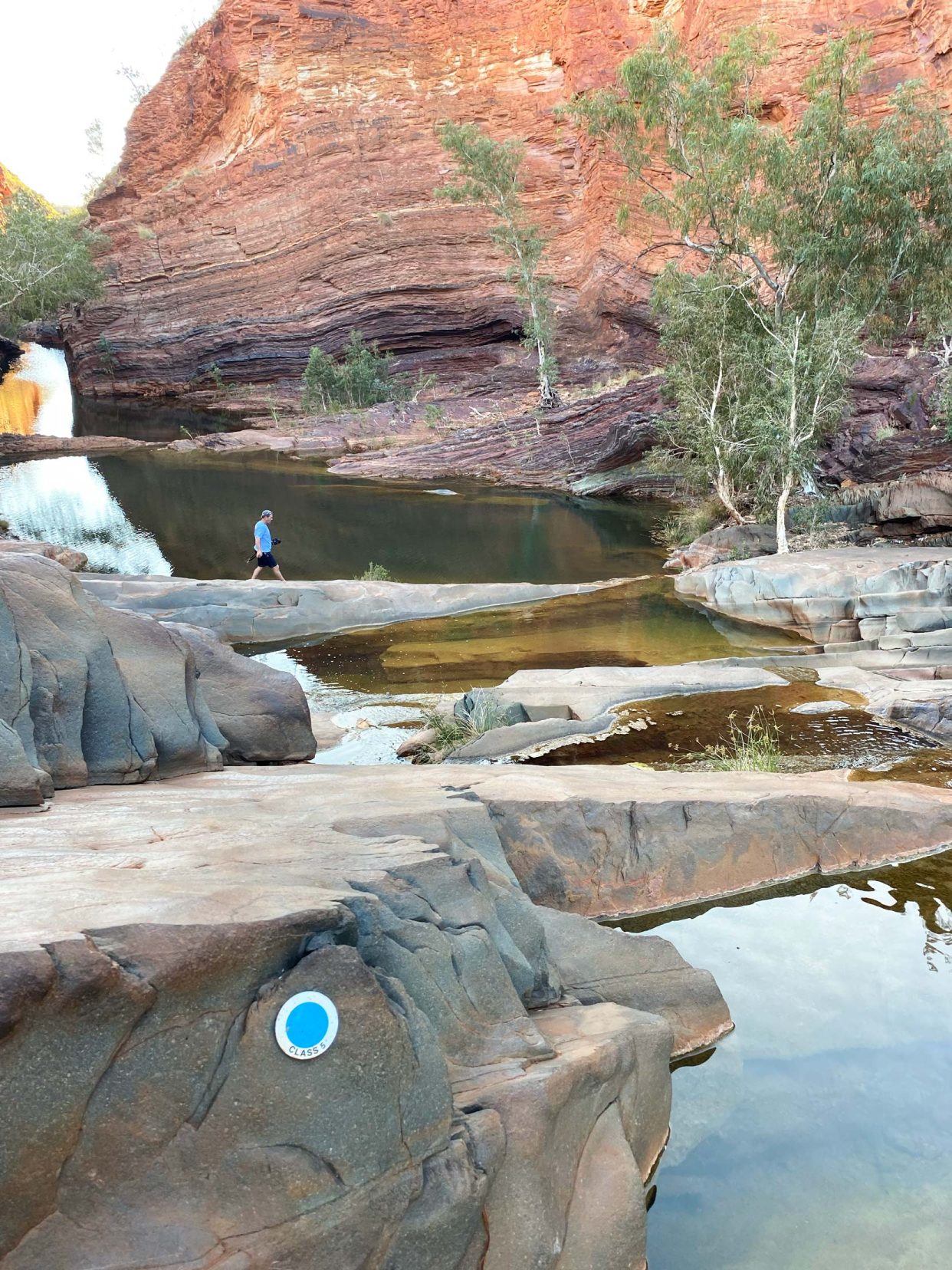
6. Stick to the Marked Trails
It’s crucial to stay on the designated paths in Karijini. The steep, narrow sections of some gorges can be dangerous if you’re not careful. Always follow the signs and markers, and avoid taking shortcuts.
Pro Tip: Many gorge trails have specific entry and exit points. For example, Hancock Gorge has ladders and safety signage to guide hikers.
7. Watch Out for Wildlife
While wildlife encounters in Karijini are often a highlight, it’s important to keep a respectful distance from animals, especially dingoes. Never feed wildlife, and be cautious of snakes when walking on rocky or grassy areas.
Pro Tip: If you encounter a dingo, stay calm, avoid running, and keep your food secured at all times.
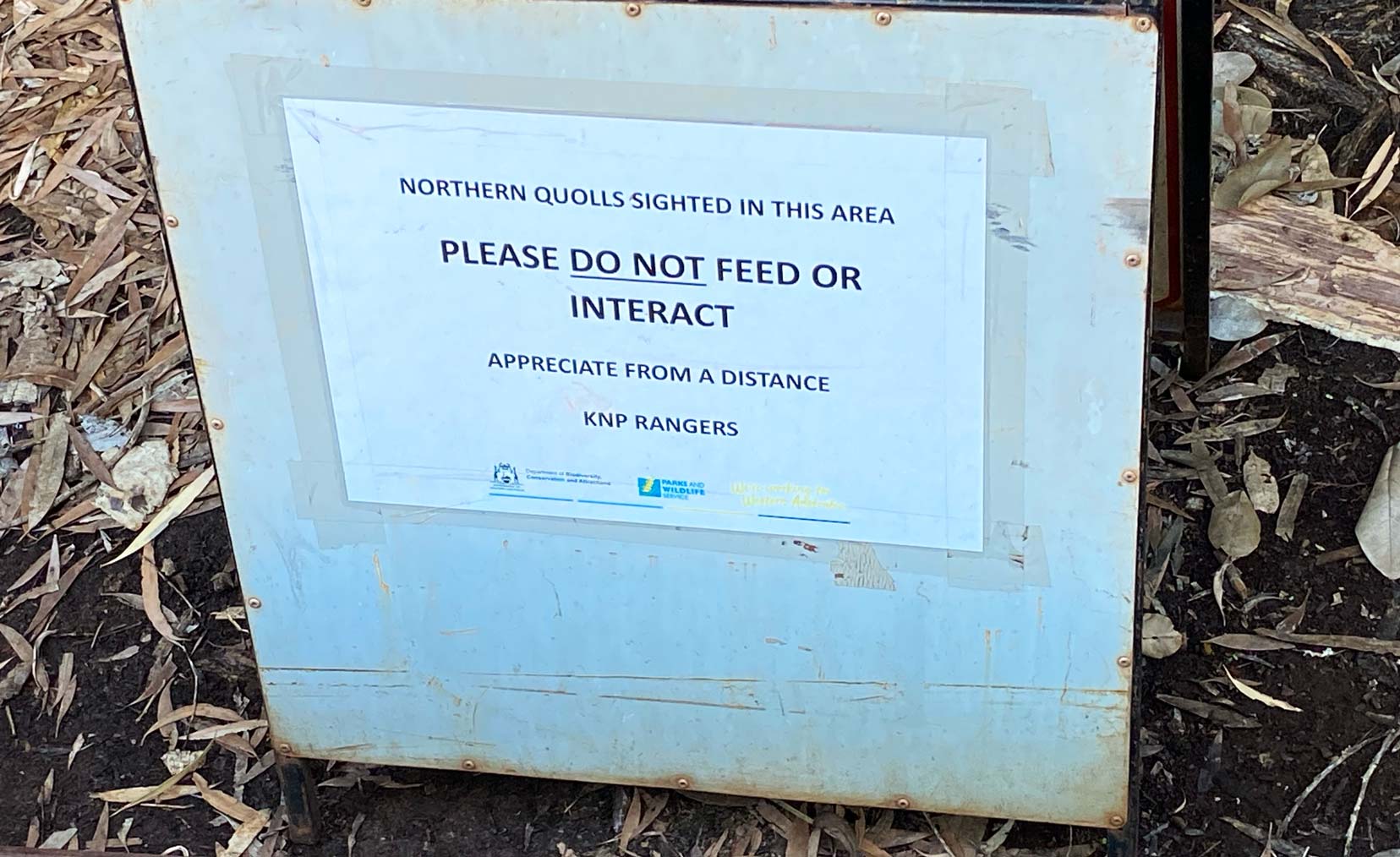
FAQS: Important Karijini Visitor Information
Here, we cover the many questions that visitors may have.
1. How to Get to Karijini National Park?
Karijini is located in the Pilbara region of Western Australia, about 1,400 km north of Perth. The closest town is Tom Price, approximately 100 km away, where supplies can be stocked. Visitors can fly into Paraburdoo Airport and drive 120 km to the park.
2. What’s the best time to visit Karijini?
The best time to visit Karijini National Park is between April and September when temperatures are cooler and hiking conditions are more suitable.
3. What is the Closest Town to Karijini National Park?
Tom Price is the closest town, about 100 km from the park. It has a Coles, petrol stations, and basic services.
4. How Many Days Do You Need at Karijini?
To fully enjoy Karijini, you should spend at least 4 to 5 days there. This allows enough time to explore the main gorges, take in the park’s beauty, and not feel rushed.
5. Do I Need a Park Pass for Karijini?
Yes, a National Park entry fee of $17 per vehicle per day is required. You can also purchase an Annual All Parks Pass for $120, which covers entry to all national parks in Western Australia.
6. Do I Need a 4WD to Get to Karijini?
While most roads in Karijini are sealed and accessible with a 2WD, the roads to Kalamina Gorge and Hamersley Gorge are unsealed. A 4WD is recommended for these rougher tracks.
7. How Hard Are the Walks at Karijini?
The grading difficulty of the walking trails in Karijini ranges from easy to difficult. Dales Gorge is relatively easy, while Hancock Gorge is a Grade 5 hike, requiring good fitness and careful footing.
8. How Much Does It Cost to Go to Karijini National Park?
The entry fee to the park is $17 per vehicle per day.
9. Does Karijini Have Phone Reception?
Phone reception in Karijini is limited. Telstra and Optus coverage is available at Karijini Eco Retreat and the Visitor Centre, but only Optus coverage is available at Dales Campground.
10. Are There Showers at Karijini?
Yes, showers are available at Karijini Eco Retreat, which offers hot showers and other amenities. Dales Campground, on the other hand, only has basic drop toilets and no showers.
11 Are There Crocodiles at Karijini?
No, there are no crocodiles in Karijini National Park. The park is far from crocodile habitats, primarily found in the northern regions of Australia.
12. Are There Mosquitoes at Karijini?
Yes, mosquitoes can be present in Karijini, particularly near water sources. Bring insect repellent to protect yourself, especially during warmer months.
13. Are the Flies Bad in Karijini?
Flies can be an annoyance in Karijini, especially during the warmer months. Consider bringing a fly net or insect repellent to manage them.
14. Are There Snakes in Karijini National Park?
Yes, snakes do inhabit the park, but sightings are rare. Stick to marked trails and be cautious where you step, especially in rocky areas.
15. Can You Drink Water in Karijini?
No, drinking water is not available in the park. Be sure to bring plenty of water with you, especially if you’re hiking or camping.
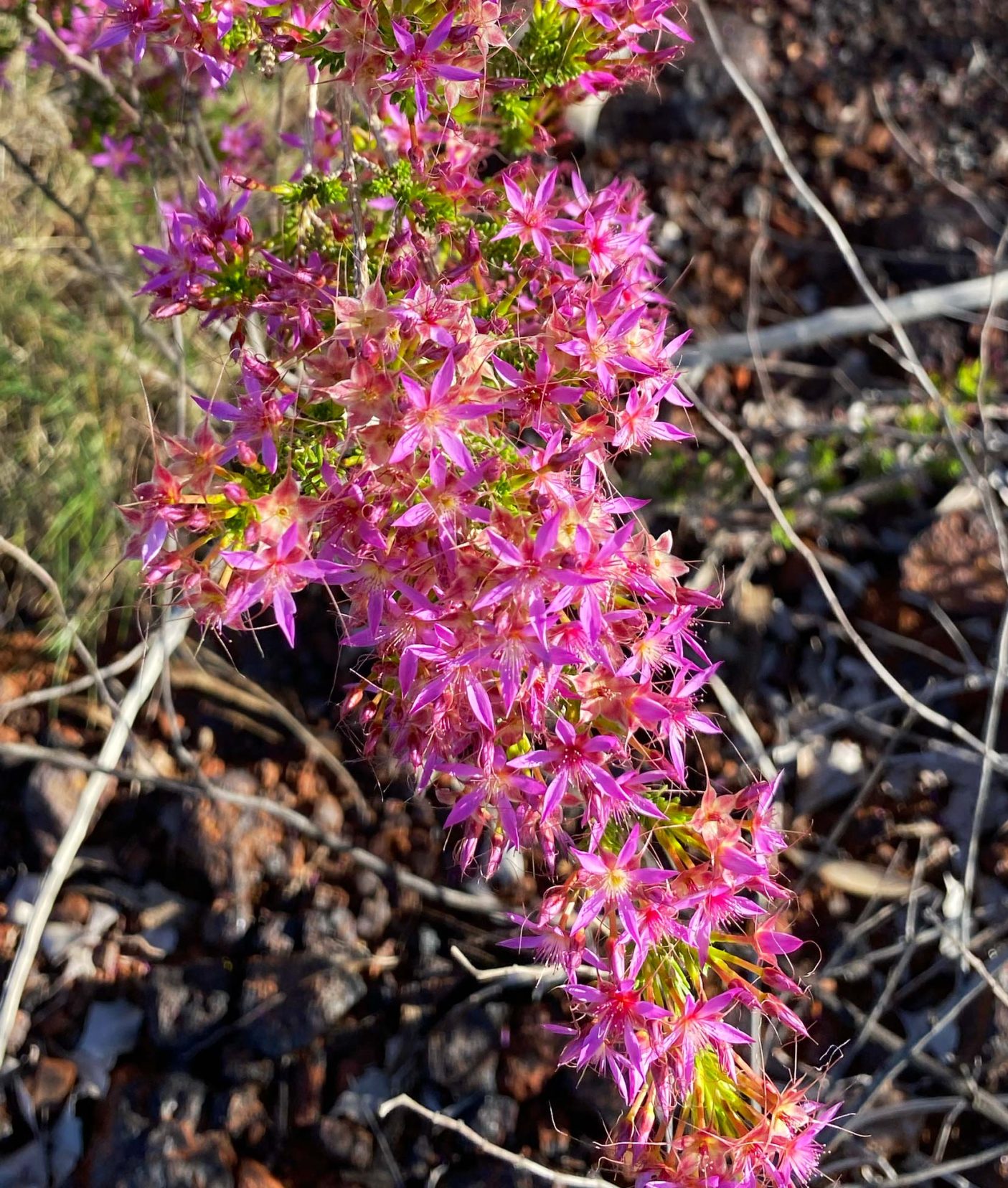
Karijini National Park Itinerary and Guide … That’s a Wrap
After such an adventurous five days in Karijini, it’s clear why this park is regarded as one of Western Australia’s natural gems. From hiking through towering gorges to swimming in crystal-clear pools, Karijini offers a true wilderness experience.
Whether you’re an avid hiker or prefer to take in the views from one of the stunning lookouts, Karijini’s unique landscape will leave you in awe.
Make sure you plan ahead, pack the essentials, and prepare to be captivated by this rugged wonderland. Download our FREE Camping Gear Checklist to make sure you have thought of everything you need:)
And when you’re ready to explore further, don’t forget to check out our Camping in Karijini Guide to get the most out of your trip!
Read More: Finding Hidden Gems between Perth & Karijini National Park
Pin on Pinterest for Later
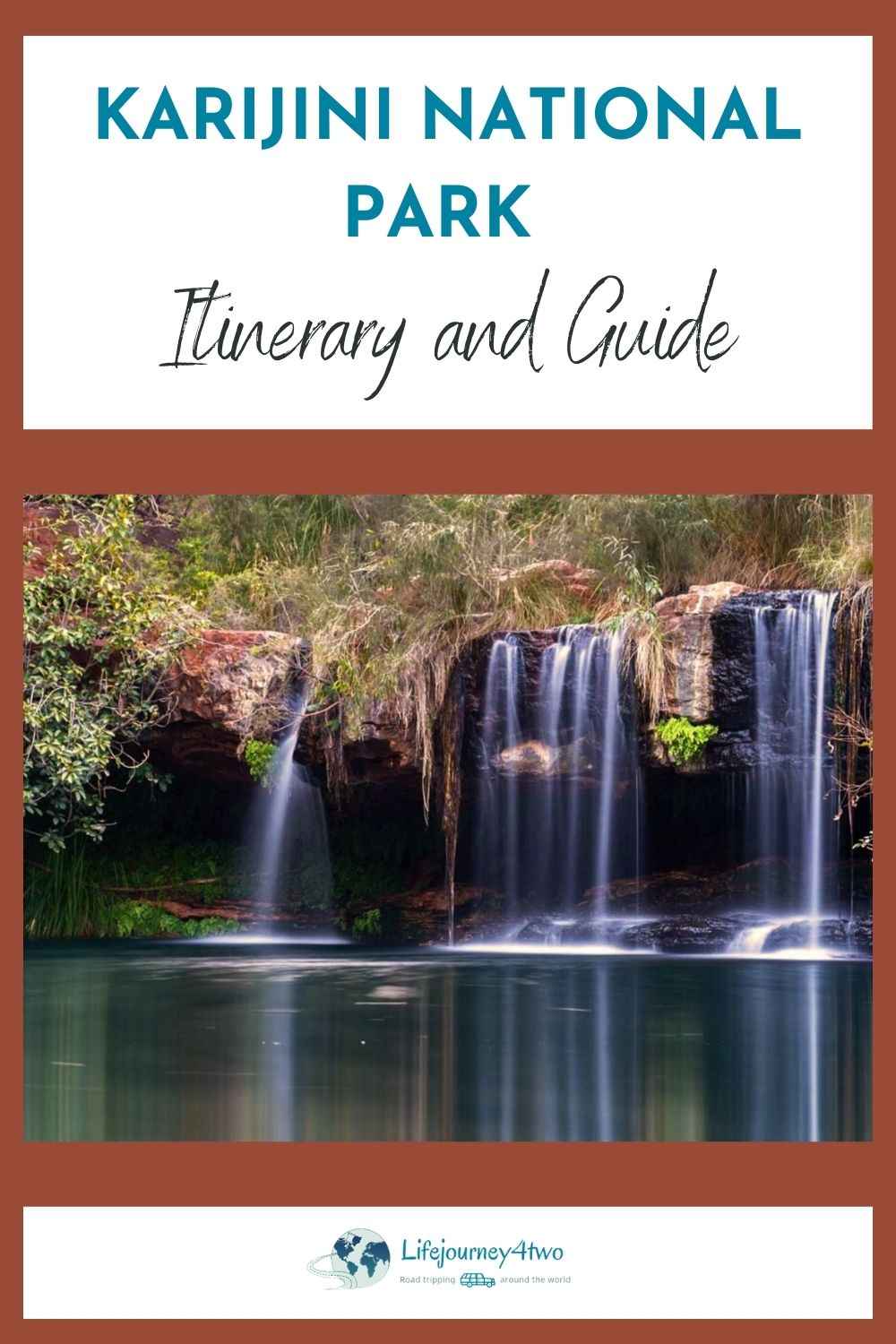
Planning Your Travels?
These are the travel resources we recommend and use when planning our trips.
- 🚘 Car Hire: We use DiscoverCars.com
- Motorhome/Campervan Rental: We highly recommend the Motorhome Republic
- 🪪 Order your International Driver’s Licence online here
- ✈️ Flights: Find flights on Skyscanner
- 🛏 Book Accommodation: We use Booking.com to find accommodation that suits our budget
- 🐶 Pet Sitting/Pet Sitters: Check Out TrustedHousesitters here (Use our Discount code: LIFEJOURNEY25 for 25% off. )
- Activities and Experiences: Get Your Guide and Viator
- Travel Insurance: Safetywing or World Nomads
- 🥾 Travel Gear and Accessories: Check out our top picks here — Lifejourney4two page on Amazon
For a more thorough list, visit our Travel Resources page here.

